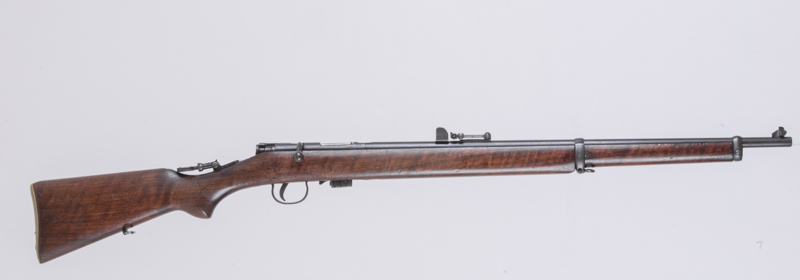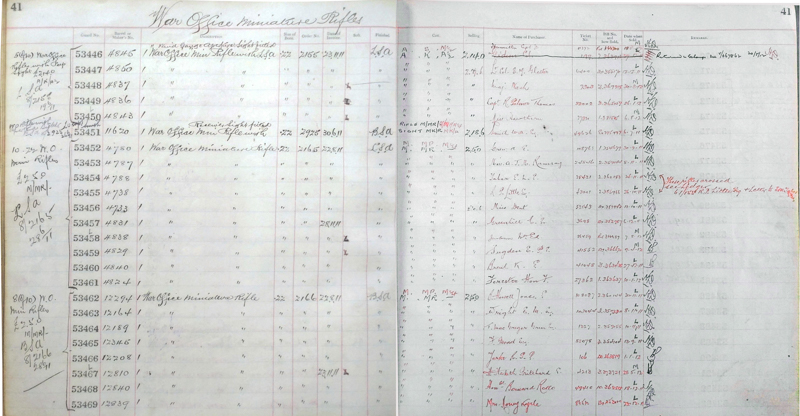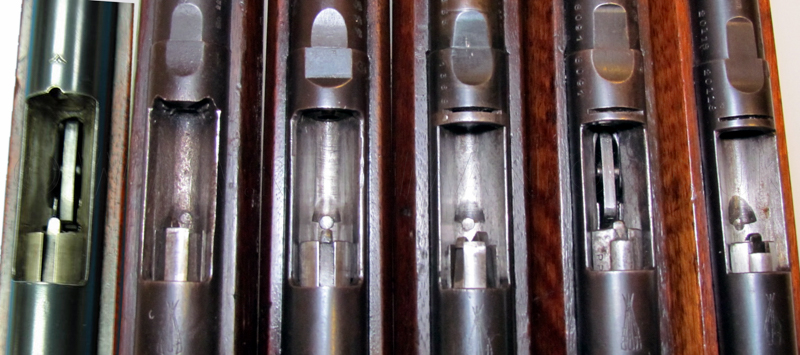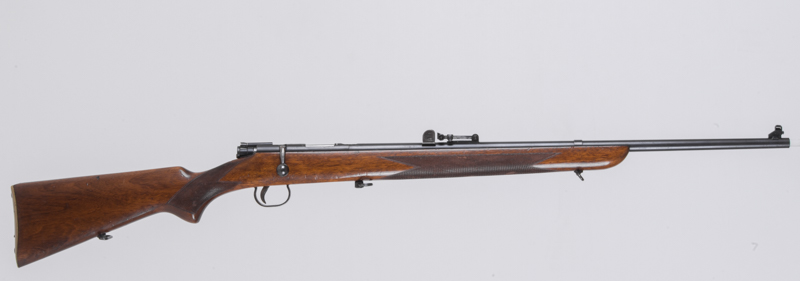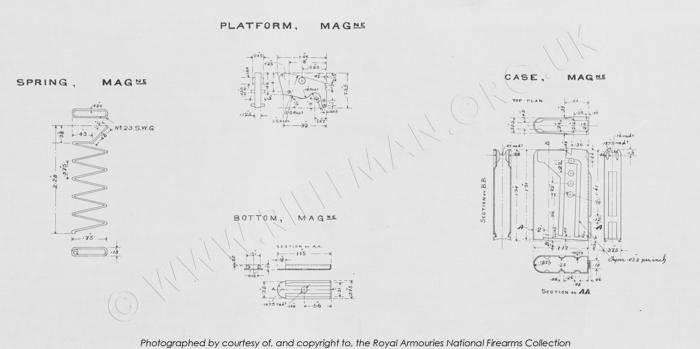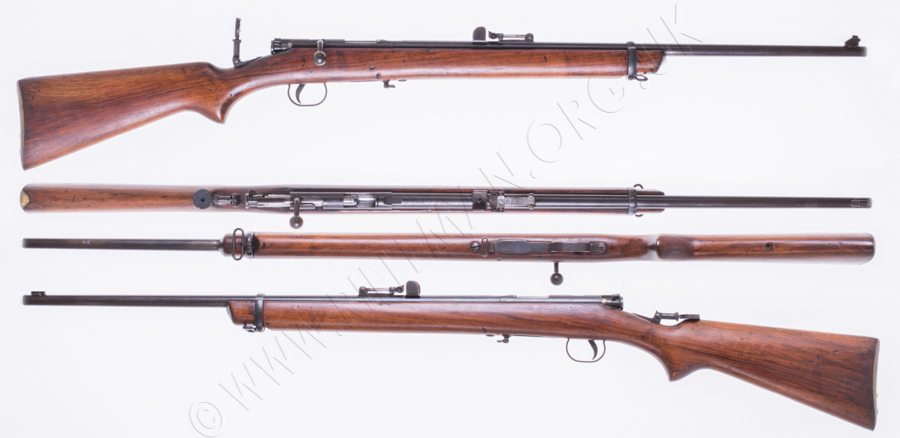See also on this page: the later 1908 BSA experimental model
and the London Small Arms eccentric folding rear aperture sight
More than ten years after the French Government had, in 1893 at the behest of the Union des Societes de Tir - ( literally the union of shooting societies), appointed a commission to develop a specification for a miniature calibre Lebel style cadet and club rifle to emulate the Lebel service weapon, an equivalent plan was set in motion in Britain. E.J.D. Newitt, in his book " The Citizen Rifleman", wrote of the conception of the War Office Pattern Miniature rifle thus:
"In the latter part of 1905 a Committee of the British War Office, assisted by representatives of the National Rifle Association and Society of Miniature Rifle Clubs, met for the purposes of determining the details of a low-power rifle to meet the requirements of the Civilian Rifle Clubs, schools and other organisations for teaching marksmanship in England."
[ Note:
the British War Office was asked to provide for the teaching of rifle shooting
in "
"In 1906 a complete specimen, constructed at the Government Small Arms Factory at Enfield, was adopted, sealed as a pattern, and is now in course of manufacture by the Birmingham Small Arms Co. and the London Small arms Co. The calibre is .22, and the pitch of the rifling is suited to the .22-5-40[grain] cartridge.
The
bolt action is similar in appearance and operation to that of the British
Service rifle. The stock has a pistol grip and short fore-arm, terminating
about eight inches from the muzzle. The weight is 5lbs. 5ozs., the barrel being tapered towards the muzzle, and somewhat thinner and lighter than the best examples of American .22 calibre rifles." [ At the time of writing, there were
only two other .22 calibre rifles of British make; the "Certus" made by the
"The sights are of military pattern, the backsight permitting of vertical adjustment by means of a slide resting upon an inclined ramp, and of lateral adjustment by means of a screw. The front sight, owing to the tapering of the barrel and height of the backsight, has a total height of three-quarters of an inch, the point being protected by a neatly designed hinged cover. The radius between the sights is 18 inches. The Continental system of long pull or draw trigger, and swivels and sling similar to those of the Service arm, which this rifle resembles in miniature, have been adopted."
As just related in this contemporary
report, the rifle was put into production to a specification demanded by the
Government's War Office requirements, for a lightweight miniature calibre
training and target rifle for cadet and club use, determined after consultation
with civilian organisations. The perceived need for this was largely as a
result of the national promotion of rifle shooting after the Boer War (1899-1902),
during which the Boer riflemen employed such effective long range fire with
the Mauser rifle. The less well prepared British
forces were still using battle technique developed from Napoleonic times and
suffered heavy losses as a result. The encouragement of the populace into
rifle shooting was instigated by a number of senior military men, keen senior
civilian riflemen and politicians, in particular Lord Salisbury, with Lord
Roberts of
Mr. Newitt was modest in his description of the way in which the move to a semi-official training rifle had developed. He was personally heavily involved in the process of encouraging the Government into action on this score:
(see Society of Miniature Rifle Clubs).
Introduced in 1906, the War Office Pattern Miniature Service Rifle was designated to the design prepared for the War Office by Speed and Ashton (Joseph J. Speed and Dr. H.T. Ashton) at the Enfield R.S.A.F. (Royal Small Arms Factory). The British Patent, number 25,403, was granted to them on 6th. December 1905. Later patents, respectively in 1906 and 1907 were granted for the swivel foresight hood arrangement and the windage rearsight clamping system. These are illustrated later in the page.
Patent entries taken from "Patents for Inventions - Abridgements of Specifications - Class 119 - Small Arms"

The War Office Small Arms Committee usually dealt with the design, trialling and introduction of new service arms,
but a special committee was set up specifically for the consideration of the proposed War Office Miniature Rifle.
Unsurprisingly called the Miniature Rifle Committee, its deliberations commenced in 1905.
We have collated a huge number of the reports into six separate tranches as extremely large PDF files.
These are searchable up to a point, as the scans are not all perfect.
The optical character recognition is not able to cope entirely successfully with the various layouts,
and a considerable number of reports are in long-hand.
However, the material is almost entirely legible, presents a remarkable history of the conception of the rifle,
and affords a research opportunity otherwise not available to those remote from the original archives.
The first tranche is shown here, and the remaining five are on separate pages accessible from the follow on links.
Proceedings of the Miniature Rifle Committee 1905-06
This in the form of a large searchable PDF document, which may take a few moments to display.
Please be patient - if the subject interests you it will be worthwhile.
Double tap tablet or click ![]() for full page display.
for full page display.
Proceedings of the Miniature Rifle Committee 1905-06 ~ Tranche 2 of 6
Proceedings of the Miniature Rifle Committee 1905-06 ~ Tranche 3 of 6
Proceedings of the Miniature Rifle Committee 1905-06 ~ Tranche 4 of 6
Proceedings of the Miniature Rifle Committee 1905-06 ~ Tranche 5 of 6
Proceedings of the Miniature Rifle Committee 1905-06 ~ Tranche 6 of 6
The rifle was manufactured from 1906 both by BSA & Co ( the Birmingham Small Arms Company )
and the LSA ( the London Small Arms Co.) under licence.
Those illustrated below are all of B.S.A. Manufacture
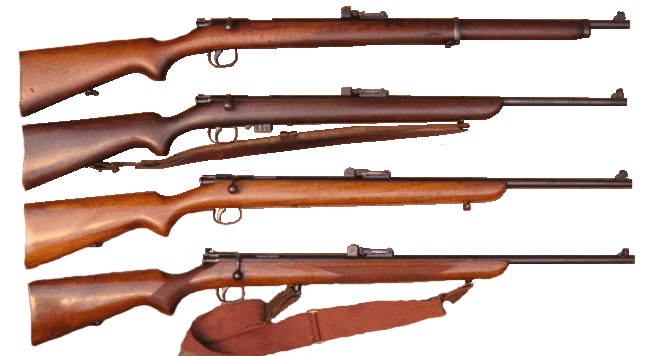
Above -Top: The full military stocked rifle Serial No. 1368 (1906); Second from top: The magazine-fed rifle Serial No. 5853 (1908)
Second from bottom: The standard civilian style rifle Serial No. 20118 (undated); Bottom: The "De Luxe" model Serial No. 20883 (undated)
The De Luxe model carries the optional centre trigger-guard sling swivel described later
The topmost BSA manufactured rifle, with the long military furniture, interestingly carries a cartouche,
on the right-hand-side of the buttstock, for
"WILKINSONS LTD. - GUN RIFLE & SWORD MAKERS - PALL MALL LONDON"
The original Enfield Pattern Room was transferred in 2001 to the Royal Armouries in Leeds. This research facility became the National Firearms Collection, which currently holds four different models of W.O.P. Miniature rifle. Of these, the most significant is shown here.
This is the earliest prototype (1905/6) held in the collection. It is a magazine fed rifle, built at R.S.A.F. Enfield, with a 7 round magazine capacity; this configuration was never put into production, and the magazine will be seen to protrude further below the rifle than the B.S.A. and L.S.A. manufactured models illustrated later.
The original Enfield produced prototype W.O.P. rifle with 7 round magazine - N.F.C. Ref: PR.5914 (RB369) - click for higher resolution
In 1907 the L.S.A.Co. submitted a version with a five round magazine for assessment. In the same year, the L.S.A. Co. submitted a further rifle for inspection. This sample was fitted with a bolt modified to a new B.S.A. Co. patent. This example is marked with serial number 1. In 1909, B.S.A. manufactured their own magazine-fed rifle, again with a five round capacity; this rifle was fitted with the 1907 modified bolt (see below). Quite early in production, the fully military stocked single shot rifle was introduced, as illustrated above. It will be seen that most rifles up to 1909 were of the sporter-length stocked standard version, even the magazine-fed models. As first marketed, the rifle was mostly sold as a single shot version. Of the total contracted production by both companies of about 160,000 rifles ( of which nearly two-thirds was contracted to the B.S.A. Co.), only a few thousand magazine rifles are understood to have been manufactured. The totals of all configurations manufactured by both companies are difficult to determine. Most of the higher serial numbers seem to be in the 20,000 range for B.S.A. Even if these serial numbers started at 1 for each type, which appears not to be the case, then B.S.A.'s total manufacture alone would hardly have met their contract for 100,000 rifles. The onset of the First World War, whilst not initially halting production of these training rifles, latterly seriously affected it, since almost all arms production was switched to service weapons.
The next two images can be rotated and zoomed, either as initially loaded or full-screen for higher definition.
Slide cursor < > to rotate, and Click to zoom.
The upper image shows the full-length military stocked magazine-fed rifle. This example is a very early production model by the London Small Arms Company, and carries the serial number 404. It is fitted with the unusual LSA folding rearsight that has a single aperture that is windage adjustable on an eccentric cam by a few degrees rotation of the whole disc. Intrinsically this is a clever design that suffers from too easy inadvertent displacement.
The lower image shows the same rifle rotating on its bore axis.
Below are the patents for the LSA folding eccentric rear aperture sight,
and a later advertisement from the A.G. Parker catalogue of 1920.
The first of three abridgments - 11,809 of 1908, is the original for the standard windage adjustable folding model. The next item is a Parker company advertisement for that model. Finally are the complete specification documents for the 1908 model, followed by that for the multi-hole aperture design.
The following patent - 12,672 of 1909 - relates to the fold-away mounting method for the Lee-Enfield/Metford rifles, while the next - 1973 of 1912 - covers the modification to the standard windage adjustment that used the same internals to slide across a bar drilled with different sized aperture holes. The mechanics which operate this multi-hole aperture arrangement have been used on a Claborough & Johnstone converted Lee-Speed rifle for the over-bore aperture extension.
Greater detail of these London Small Arms sights is also available HERE.
It may take a few moments to load.
Click Portrait button for width expansion
Double tap tablet or click ![]() for full page display.
for full page display.
The London based Army & Navy Stores retailed firearms of all types nationally, particularly supplying British officers with their privately purchased personal sidearms, rifles, and particularly Lee-Enfield carbines. The company also sold many rifles and pistols to civilian customers, and the War Office Pattern miniature rifles were a notable part of their sales, from the introduction of those rifles in 1907 to the period between the two World Wars.
We have been fortunate that a researching colleague has been able to access the records held in the archives of the Army & Navy Co-operative Stores in Glasgow.
We illustrate just one of seventy pages in the company sales ledger for the War Office miniature rifle, which includes entries for the very first three London Small Arms company's magazine-fed rifles, serial numbers 1, 2 & 3.
These are to be found on consecutive lines, listed under the second column of "Guard No." numbers 47937/8/9.
The three rifles were invoiced on the 8th. April 1908, under order number 4277.
A useful indication for those seeking to discover approximate dates of manufacture of their prized pre-WWI possessions, is that the listing shows L.S.A. Co. single-shot rifle serial numbers 305 to 3612 as being invoiced between January and June 1908, whilst those by B.S.A. Co. were serial numbered from 4706 to 5328 between January and early April.
However, it is odd to see that there is an earlier section, on 15th. January, showing L.S.A. magazine-fed rifles with later serial numbers between 226 and 341 under an earlier order number. We can only wonder if the early serial numbered rifles had perhaps been held back for some reason.
All the rifles on this page were of .22LR calibre; not a one being in the optional calibre of .297/.230" Morris.
It is interesting to note the pricing of the few "Best Quality" B.S.A. models at £2:15s:0d (£2.75). This was ten shillings ( 50p) more than the price of the standard single-shot rifle advertised in the Army & Navy stores catalogue of 1907 ( illustrated further down this page).
The first untitled column carries these prices, under each of which is a coded price, presumably that for the cost of each rifle. Such codes were very common in retailing, and some remain in use to this day. The code is usually very simple, consisting of a ten letter phrase that has no repeat characters; the letters of the phrase represent numbers 1 to 9, plus a zero that could be at either end.
The displayed code for the standard two pounds and five shillings model is "M/MR/-", and that for the Best Quality two pounds and fifteen shillings rifle is "A/E/-".
We await, with bated breath, a code-breaking reader's discovery of the phrase used, which should afford the cost prices of the two rifles, and the profit margin of the Army & Navy Stores in the early Twentieth Century!
The ledger page can be more closely inspected.
Hover over or Click image to bring up hi-res file and magnifier
Nowadays the magazine-fed rifles are quite rare and often missing their magazines. The magazine rifle was particularly used by the Military, and the 1910 edition of Musketry Regulations reports specifically on the employment of this model with its five round magazine capacity. The regulations describe the rifle as being fitted with a barrel rifled in the 'segmental' Metford style.
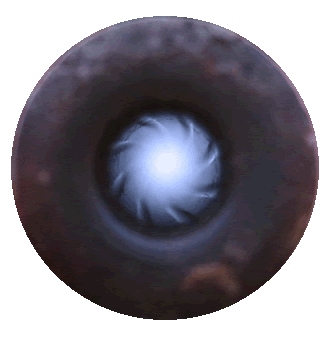 The
image to the right illustrates that the grooves are indeed radiused, but on a very different scale from the .303 Metford rifling, each 'land' taking a larger segment of the circumference of the bore
than the rifling of a full-bore barrel. Additionally, the groove depth is
effectively greater, being a larger percentage of the radius of the bore in
the .22 barrel than the .303.
The
image to the right illustrates that the grooves are indeed radiused, but on a very different scale from the .303 Metford rifling, each 'land' taking a larger segment of the circumference of the bore
than the rifling of a full-bore barrel. Additionally, the groove depth is
effectively greater, being a larger percentage of the radius of the bore in
the .22 barrel than the .303.
The rifles were fitted with barrels of 24" length. The rifling is - as can be seen above - 8 groove and the rifling twist is 1 in 16.
(N.B. should a cursory glance at your own rifle indicate a bore with 6 grooves of a flat nature, in the more modern style, it has probably been re-sleeved in the manner of Parker rifling).
Next: the relevant section from the blueprint of the rifle's components.
The Royal Small Arms Factory, Enfield Lock, Drawing no. 2221A
By courtesy of the trustees of the Royal Armouries
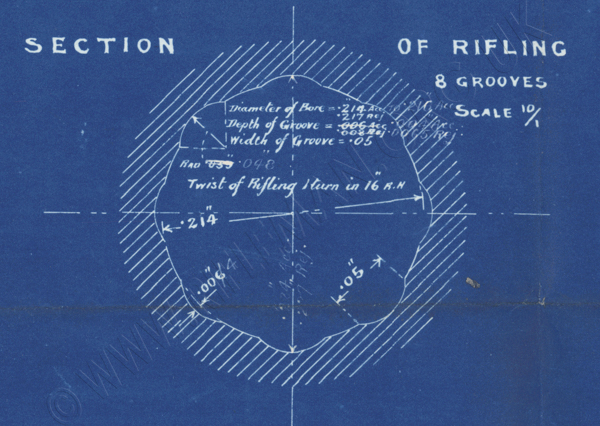
At risk of being accused of an off-topic diversion, it is probably worthwhile to relate the origin of the Metford type of rifling .
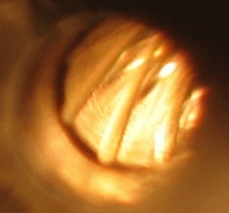 The Metford rifling was used mainly in the Enfield Martini rifles
- adopted in 1886 - and subsequently in the early marks of Magazine Lee Metford (M.L.M.) "Long Lee" rifles. Metford eliminated the sharp corners or edges most commonly
employed in rifling design. His system was designed to limit fouling of the
barrel by the residue of burnt powder, which built up after several shots
were fired and affected accuracy by interfering with the passage of the projectile.
The Metford rifling was used mainly in the Enfield Martini rifles
- adopted in 1886 - and subsequently in the early marks of Magazine Lee Metford (M.L.M.) "Long Lee" rifles. Metford eliminated the sharp corners or edges most commonly
employed in rifling design. His system was designed to limit fouling of the
barrel by the residue of burnt powder, which built up after several shots
were fired and affected accuracy by interfering with the passage of the projectile.
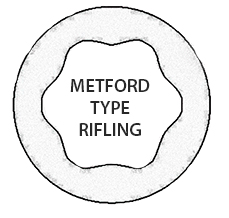 This situation, a problem particularly evident when gunpowder (black powder)
was the only propellant available, was much reduced with the introduction
of nitro-glycerine based explosive. This is believed first discovered by theGerman Christian Schönbein of Basle, (a contemporary
and student of Michael Faraday) in 1846, in the form of "guncotton"
and further developed by the Swedish born chemist Alfred Nobel near
This situation, a problem particularly evident when gunpowder (black powder)
was the only propellant available, was much reduced with the introduction
of nitro-glycerine based explosive. This is believed first discovered by theGerman Christian Schönbein of Basle, (a contemporary
and student of Michael Faraday) in 1846, in the form of "guncotton"
and further developed by the Swedish born chemist Alfred Nobel near
Above: The rifling 'leed' (lead) at the front of the chamber 
In the form of "Cordite", a hybrid of nitro-glycerine and nitro-cellulose, a stable and reliable "smokeless" propellant was invented. Cordite was developed by Prof. Sir Frederick Abel working with Sir James Dewar ( see the Dewar rifle and competition), also contemporaries of Michael Faraday, at the Royal Institution, for the W.D. (British War Department) in 1889. The product was manufactured as a fine stranded extrusion.
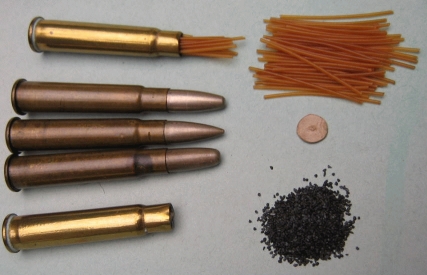 Left top: Cordite
Left top: Cordite
Centre: .303 inch Rounds - various, with cardboard wad that is placed between strands of Cordite and bullet
Bottom: Black powder as used pre- Nitro-based propellants
Above right: plaque celebrating fifty years since the invention of Dynamite
In production, the propellant was packed into a cartridge case along the lines of a packet of miniature spaghetti. Cordite was commonly used in most ammunition by the time of the First World War ( 1914-1918), still in use in the Second World War ( 1939-1945), and for many years after in some corners of the world; indeed, it is still occasionally found available as surplus .303-inch ammunition today - more than half a century later.
But we digress!
The B.S.A. Co. advertised their version of the W.O.P. rifle extensively. The examples on this web page are all in the most commonly produced calibre of .22-inch rim-fire. However, the following two images of pages, from their 2nd. edition 1909 catalogue, illustrate that the rifle was also available in the .297/.230-inch calibre for the Morris cartridge which, by this time, had already been in use for many years with the Morris Aiming Tubes used for miniature calibre training by the military. These sub-calibre tubes were available for many types of Enfield rifle and carbine - both Martini and bolt action - chambered for either the Morris Short or Long cartridges.
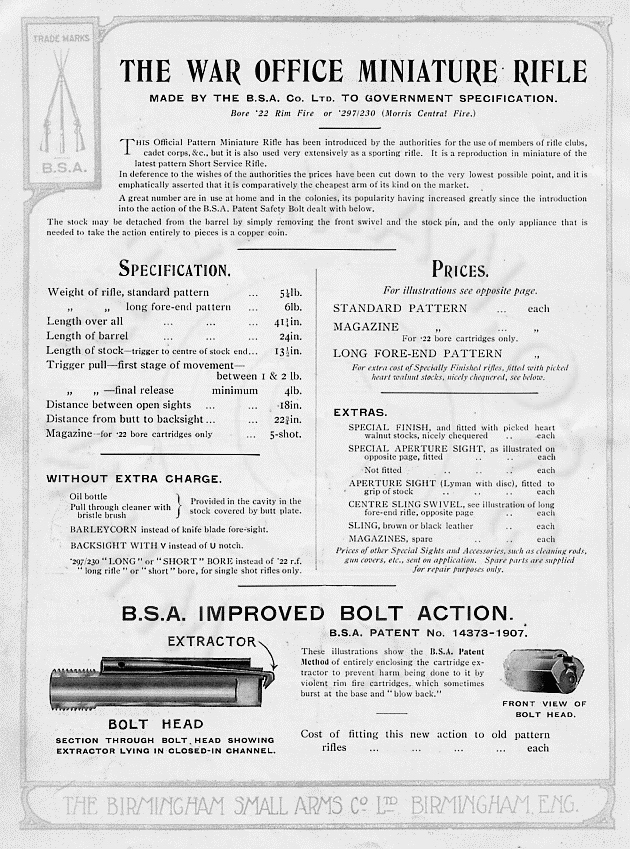
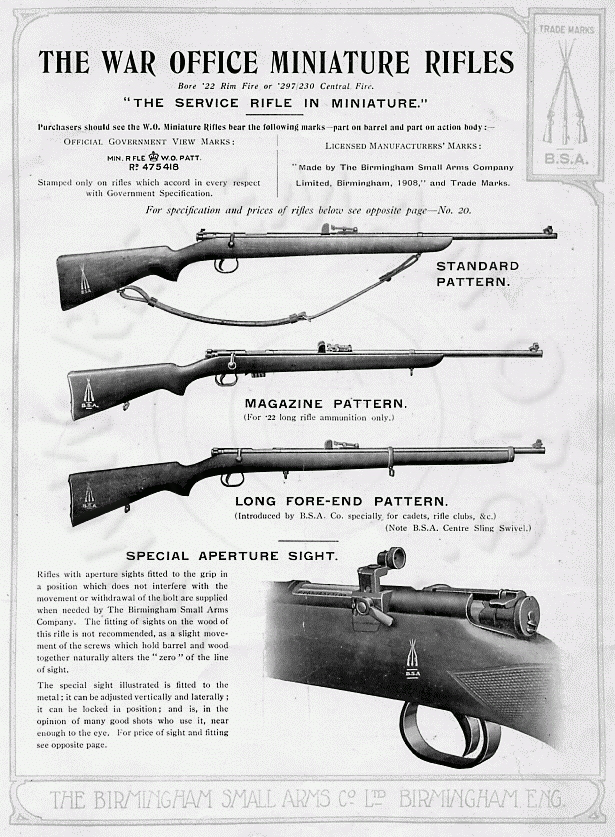
It should be noted above that, already, B.S.A. were offering a retro-fit aperture rear-sight in an attempt to encourage use of the rifle for target shooting rather than mere military style training; this was probably rather wishful thinking - as can be discovered when reports of the rifle's performance against its contemporaries can be read further on in this article.
The main bolt-head variations
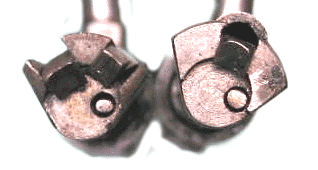
There were at least three variations in bolt design over almost nine years of production . The first was a single overhead extractor system, not pictured, but shown in the first figure on this page in the Patent Drawing No. 25403 of December 1905, and similar to the right hand example in the above image - although without the covering hood (integral with the bolt-head) which was an Autumn 1907 B.S.A. Co., modification to prevent breakage of the extractor and to protect both the firer and the extractor in the event of a blowback from a split cartridge case. Shown left in the image above, and as described in John Knibbs's 2002 published, and comprehensively detailed, book of the history of a hundred years of B.S.A. production ( "The Golden Century" - see Recommended Reading), yet later models were fitted with the further improved double claw extractor arrangement ( illustrated above left) which was capable of withdrawing the most obstinate of cases from the chamber. Strangely though, the patent for this double claw design was granted to B.S.A. in January of 1907, nearly six months before that for the hooded extractor. With the introduction of the double claw bolt-head, at whatever date, the earlier problem of split cases damaging the extractors seems to have been further obviated; whether this is as a result of more reliable ammunition, or strengthening of the extractors, or a combination of the two factors, is not certain. The more common hooded extractor bolt-head design was the " improved" version patented by B.S.A. Co., (above right) as described in the contemporary advertisement illustrated immediately above this image. Few of the original design of bolt-head will be seen, probably because B.S.A. heavily advertised their 1907 modified version as a retro-fit, although not a cheap option at over fourteen shillings (fitted) in the early years, nearly a third of the price of a new W.O.P. rifle at 45/-, whilst a far superior Model 8 Martini-actioned target rifle could be had at little over 50/-.
Below is an image of a section of the R.S.A.F. drawing of the components of the W.O.P. Miniature rifle showing the bolt detail.
By kind permission of the Trustees of the Imperial War Museum
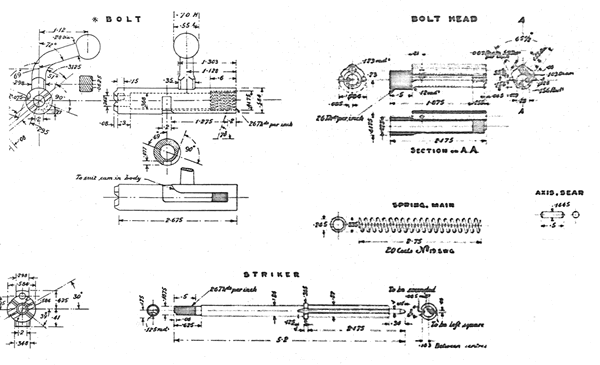
Below left is an image of the single extractor unhooded bolt-head of an early London Small Arms Company rifle, to the original R.S.A.F. drawings, and, right, another image in which are shown both the BSA twin extractor bolt-head and their patented version with the integral hood protecting the extractor spring , which can clearly be seen as part of the newly designed casting for the bolt-head on the right; Patent number 14373 - August 1907.
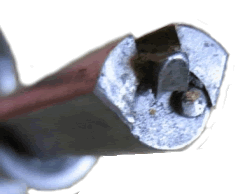
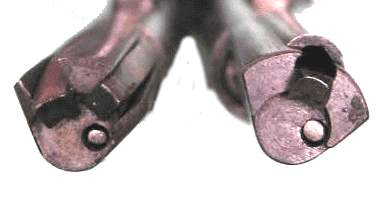
The firing-pin is offset for the rim-fire cartridge
The need for this modification to the original bolt-head is clearly explained in an entry in " The Rifleman" the Journal of the Society of Miniature Rifle Clubs, (indeed today still the Journal of the National Small-bore Rifle Association ), in August 1907 - which reads as follows:
THE " WAR OFFICE " MINIATURE
RIFLE.
"A number of somewhat mis-leading paragraphs have recently appeared
in the Press with reference to the above, as regards the firms in Birmingham
who manufacture the weapon. Although more than one are at present licensed
to do so, only two have availed themselves of the permission, namely, The
London Small Arms Co., Ltd., and The Birmingham Small Arms Co., Ltd., and
chief point in which interest is centred is the fact that unfortunately in
a number of cases faulty cartridges have caused the breakage of the extractor
of the " War Office " Miniature Rifle. This matter has been very
carefully considered for some time past by the London Small Arms Co., and
they have obtained the sanction of the War Office to manufacture W.O.M. rifles
with a new pattern single extractor and a safety hood, which is formed bv
the continuing of the body projecting in the front of the bolt-head and the
extractor. The firm have made very careful tests with this rifle in conjunction
with the Government Officials, and the results obtained prove that with the
modified body it is impossible for a bursting cartridge to blow out the extractor."
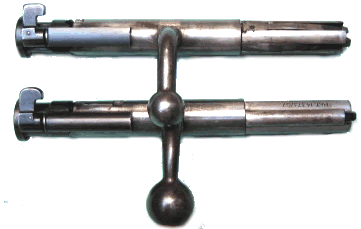 To
the left is an image showing the January 1907 patented, twin extractor, bolt above, and the
August 1907 hooded single extractor version below. The bolt safety catch arrangement, representative
of that on the .303-inch calibre "Long" Lee-Enfield rifles and reminiscent
of that fitted to the Mauser rifles, is also evident.
To
the left is an image showing the January 1907 patented, twin extractor, bolt above, and the
August 1907 hooded single extractor version below. The bolt safety catch arrangement, representative
of that on the .303-inch calibre "Long" Lee-Enfield rifles and reminiscent
of that fitted to the Mauser rifles, is also evident.
The root of the bolt-handle forms the bolt locking lug and engages in the indent to the RHS, into which the machined handle slot can be seen to lead, in the image below of the bolts in the open position.
This method is still commonly
in use today by manufacturers of many small-bore sporting and target , although
most safety catch designs operate at the side of the bolt or directly on the
trigger and sear mechanism rather than
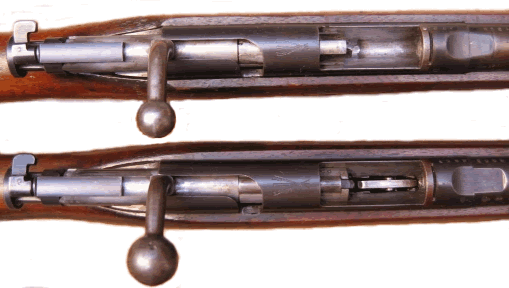 Right
is an image comparing the single shot receiver (above)
Right
is an image comparing the single shot receiver (above)
with that of the magazine rifle (below).
It has been related that the original magazine design
was for a seven round capacity.
However, only the five round version was put into production.
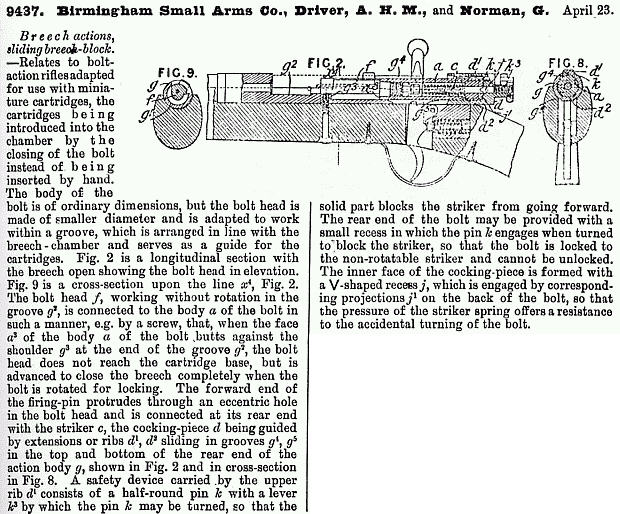
The specific way in which the
receiver of the original single-shot
rifle was constructed,
with the shaping of the receiver
providing a tapered loading platform,
and the bolt head being
profiled to that shape to permit
direct feeding of the round into the
chamber when the bolt was closed,
was obviously felt by B.S.A. to be
a patentable design,
because they applied for that patent
( shown left)
 and it was granted in 1906 on April 23rd.,
and it was granted in 1906 on April 23rd.,
only four days after that for the foresight protector.
The BSA registered patent no.1000 shown below was also significant in that, for whatever reason, it specifically reiterated the design for a non-rotating bolt-head which would allow of a round placed into the specially shaped receiver bolt-way being fed directly into the chamber by the closing of the bolt, but additionally dealt with the idea of a twin extractor bolt-head.
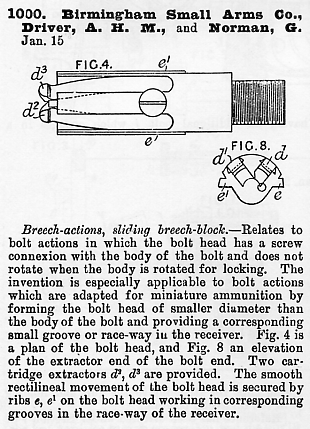
The twin extractor bolt-head,
shown earlier in the page as the upper examples in
the bolt comparison and receiver comparison images, was granted
patent in January 1907. The patent entry is here left.
The system was not manufactured for long because, by June of that
year, a further patent, for what proved to be the longer serving
design, was granted. This patent, No. 14,373, is that stamped
prominently on the bolt-heads of most surviving W.O.P. Miniature
rifles and is familiar to those who have used these rifles during their
respective lifetimes.
That patent entry is shown below.
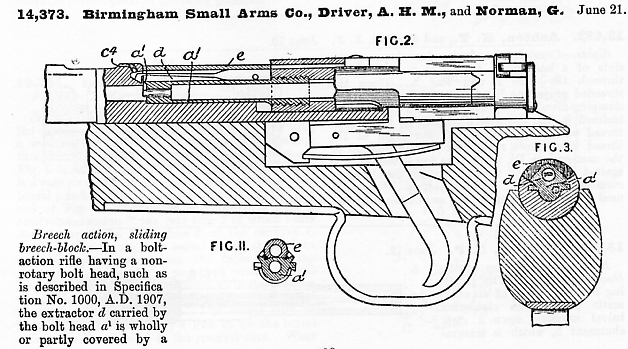

To delve a little more deeply into the progression of action design from prototyping to the latest production model, we assembled rifles together, and prepared some notes and images affording the differences.
Only early examples had other than the thin slot cut laterally across the action about ⅝” long and 1/16” wide, and sited ⅛” forward of the front edge of the receiver. This appears to have been applied to BSA rifles of s/nos. near 1368 and beyond, possibly at the same time as the introduction of the hooded extractor to BSA patent no.. Earlier rifles have at least three variations of the design of the breech and receiver front end. The first of these rifles is as shown below on the left. This rifle is the RSAF prototype magazine-fed example with no markings other than the broad-arrow. The face of the chamber is flush with the line of the front of the receiver except for the relief cuts for extractor tips. There is simply a semi-circular cut-out in line with the single extractor at the centre of the top of the barrel, which, on this prototype, is in one piece with the action body. This arrangement appears to match the original Ashton and Speed patent no. 25,403 of 6th. December 1905. The second type, BSA model s/no. 368 of 1906 – rifle no.2 below – has two similar semi-circular cut-outs, one either side of the receiver loading aperture, which are in-line with the twin extractors of the early BSA patent bolt-head (no.1000 of 15th. January 1907); as on the prototype the only cuts in the breech face are reliefs for the extractor tips . The third type – rifle no.3 below – is the LSA model (s/no. 531 of 1906), with a plain front to the receiver opening and a single extractor almost identical with the prototype, to the RSAF Drawing, and the 1905 patent. The breech face is as No.2, but without the semi-circular cuts. There is now an annular groove just over 1/16’ wide radially, and running circumferentially around the same segment as the loading-bay. The extractor relief cut runs into the annular gas groove.
Comparison of six rifle actions - prototype on left
All rifles to the right of the prototype, on the left, have separate barrel and action-bodies.
For identification within text, rifles are numbered 1 to 6 – left to right.
Click or tap to zoom
Rifle no.4 above, BSA model s/no.1368 with an unclear date mark of 190*, but probably also 1906, has the gas vent slot described previously but, on close inspection, it will be seen that this is an addition. Slots about ⅛” square have been machined either side of the receiver opening to permit fitment of a curved segment of which the front face has been relieved to effect a slot when put in place. The bolt-head is still of the twin extractor type, and no other modification has been made to specifically accommodate these, but the bolt-head now runs into the recess effectively formed by the addition of the gas hood. The breech face is otherwise as rifle no.3.
Rifle no.5 above is the BSA magazine-fed model, s/no. 8091 of 1909 manufacture. This rifle is fitted with the hooded extractor to BSA’s patent no. 14,373 of 21st. June 1907. The gas vent slot is now cut into the action body, and the bolt-head runs into the newly formed recess, but the extractor hood is cut back to clear the top of the receiver. It should be noted that the length of the receiver aperture has therefore been reduced by ⅛” from its original overall length of 1¾”.
The final, sixth, BSA rifle on the right, s/no. 20118, is identical with number five other than being a single-shot model rather than a repeater. The breech faces of both rifles no. 5 and 6 are flush with the front of the gas vent slot, and carry just the one relief cut for the extractor tip at top centre.
It is important to note the reason for the addition to the bolt-head of the integral hood for the extractor. There had been problems with the flat-spring-steel ejectors, which are held in place in the bolt-head by fine dovetailing at the rear, and a small recessed pin to prevent slippage. With little limiting of their travel upwards, to allow the claw to ride over the cartridge-case rim when closing the bolt, gas escape from the bursting rim of a higher power cartridge would sometimes break the hardened extractor. This is precisely what has happened to the right-hand of the twin extractors on rifle no.2 above. The dovetailed end of the extractor remains in the bolt-head, but is hidden under the rear of the receiver in the photograph above. The June 1907 patent by BSA sought to solve this problem, and the fact that the design remained in use until close of production eight years later, and was also employed on the subsequent commercial .22LR BSA rifle models, serves to illustrate its suitability for purpose.
Comparison of the breeches of the five production rifles shown in the image above.
Click or tap to zoom
The sights
of the War Office Pattern Miniature rifle
Below left: the rear-sight as
illustrated in an advertisement from the 5th. edition - 1912 - of the B.S.A.
catalogue.
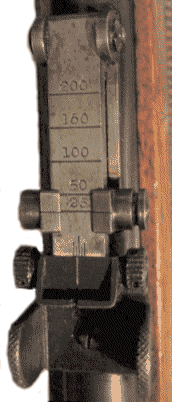
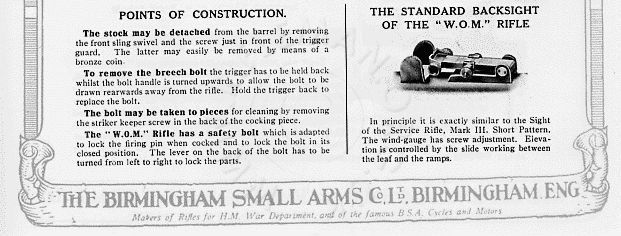
The rear sight was intended to represent
that of the full-bore Service rifle. The tangent sight leaf was 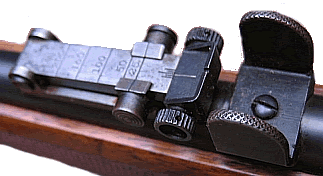 calibrated for 25, 50, 100 and 200 yards and carried a fine windage adjustment. Probably more to enhance the emulation of the Short Magazine Lee- Enfield rifle than to afford protection of
calibrated for 25, 50, 100 and 200 yards and carried a fine windage adjustment. Probably more to enhance the emulation of the Short Magazine Lee- Enfield rifle than to afford protection of
the sight leaf, a pair of protector wings, to replicate those on the S.M.L.E., were fitted into a recess machined into the barrel immediately behind the twin windage adjusting knobs. This, unlike the .303 Service arm, permitted windage adjustment without the necessity to raise the sight leaf well clear of its ramp in order to gain access to the adjuster.
Below: the markings and Patent numbering on the 1908 model

What my well have been the
much earlier patent for the
rear-sight windage
adjustment arrangement
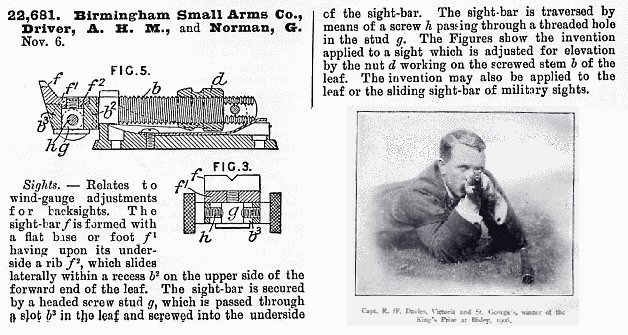
albeit the windage block and screw are shown attached to a S.M.L.E. type rearsight leaf with the worm and screw system of elevation adjustment.
This was not used on the W.O.P. rifle, which utilised the simpler sprung button clamping method.
For the W.O.P. Miniature rifle, BSA especially designed a foresight with an integral flip-over protector hood -
- and the patent granted in 1906 is here shown; although the hood in the patent drawing swivels in line with the barrel, whilst the production version hinges across the barrel. It is interesting to note that that same production sight, as shown on the rifle on this page, was also used on the contemporary French training rifle, the Buffalo-Lebel. We are unsure which came first.
Certainly, the production model would have been cheaper to manufacture than the design in this patent, which had a complicated locking arrangement to hold the hood in position - either up or down. The rifle could therefore have been fired with it in either position. The production fore-sight's hood only permitted firing (or at least sighting) with the hood down, and it would only be raised for carrying or storage. The lateral hinging automatically obviated displacement on firing.
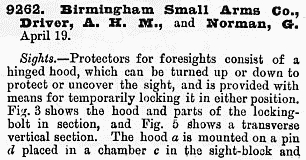
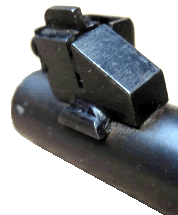
The fore-sight: -
- Right:
...................................hood down...............
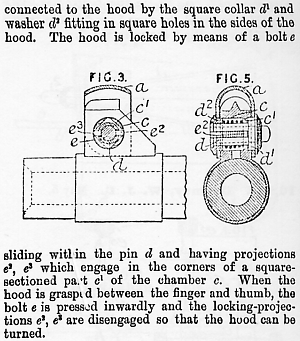
....and hood up....... 
 Left are two
close-up images allowing easy
Left are two
close-up images allowing easy
comparison of
the stock wrist, trigger guards
and magazine position on the
production magazine fed rifle.
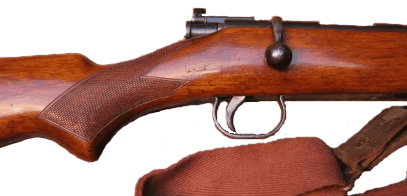 The lower
image well illustrates
The lower
image well illustrates
the wrist chequering of
the " DeLuxe" commercial model.
............................... ....................
The next two images can be rotated and zoomed, either as initially loaded or full-screen for higher definition.
Slide cursor < > to rotate, and Click to zoom.
The upper image shows the single-shot DeLuxe rifle under discussion.
The lower image shows the same rifle rotating on its bore axis.
The prototype 7 round and production 5 round magazines are here shown together for comparison
 images
by courtesy of
images
by courtesy of 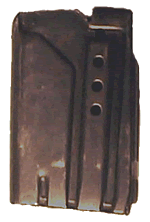
respectively the Enfield Pattern Room and the Trustees of the Imperial War Museum
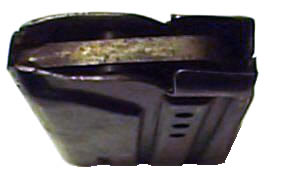 The 5 round
magazine showing the slender loading platform
The 5 round
magazine showing the slender loading platform
NOTE: We were made aware, thanks to a researcher and collector from North America, that the magazines shown here for the War Office Miniature rifle, particularly the prototype's seven round version, bear more than a passing resemblance to the magazine fitted by the Savage Arms Company to their 1903-1906 Model Repeating Rifle. We have produced a page to cover this subject seperately, with a comparison between the War Office Miniature Rifle's prototype magazine, production magazine and the Savage 1908 .22 magazine and its 1904-08 Patent. It should be mentioned that, for those owners of magazine-fed War Office Miniature rifles whose proud possessions are missing their magazines, and from whom we often receive enquiries of where replacements might be obtained, it occurs to us that either original or modern replacement Savage magazines might at least offer a source of units to put their rifles back into commission. Do look at the link above though for dimension details. One supplier of such units is the "Gunclip Depot" in the U.S., under their stock number M1166. We have yet to obtain one of these to put it to the test, since they are apparently all-too-often out of stock, but we hope to do so eventually. The Numrich Gun Parts Corp. also market these replacement magazines.
We have also embarked upon the modification of the magazine from a B.S.A. Sportsman Five rifle. This is a conversion suitable for anyone with modest metal-working and silver-soldering skills, resulting in an effectively workable magazine, albeit not a faithful replication, but which renders fully operational a hitherto all but defunct rifle.
Details of this latter means of replacing a missing magazine can be found on the page
"Replacement magazine for the War Office 1906 Pattern Miniature Rifle"
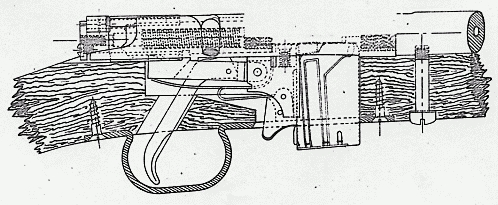
above sectional drawing of the 5 round magazine as fitted to the rifle
by kind permission of the Trustees of the
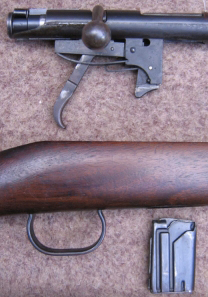 To illustrate
the ease of stripping engendered by the B.S.A.
To illustrate
the ease of stripping engendered by the B.S.A.
images, right and below, show how, by slackening the main barrel bedding screw
in front of the trigger guard, and
unscrewing the forward sling swivel, the machine screw for which engages in the threaded
boss under the barrel band, the rifle can easily be disassembled -
unlike the Canadian Ross "straight-pull" training rifle, which even requires
the barrel and stock to be separated, and the rear-sight unscrewed from the rear of the
action, before the bolt can be removed.
 .......
.......
The standard rifle was fitted with a brass butt-plate along the lines of that on the Service S.M.L.E., although it was in fact a special design, necessarily slimmer. The trap for the cleaning equipment, oil bottle and pull-through, was orientated, on the BSA manufactured rifles, with the hinge at the top, as on the .303" service rifle which it was loosely intended to emulate. Interestingly, one War Office specification drawing, detailing components for the rifle, shows an alternative butt-plate with the trap inverted, which configuration has only been seen on early London Small Arms Company War Office Pattern miniature rifle production. This bottom-hinged trap is also to be found on the Canadian Ross Cadet .22RF training rifle, there properly reflecting the layout of the full-bore Ross service rifle.
It is quite possible that this was a way of permitting the BSA and LSA companies to enjoy a small, but comparatively obvious, differentiation between their respective products. There was certainly otherwise precious little room for manoeuvre in the Government specification, over and above the markings in the form of rather less noticeable company cartouches and name or logo marks on the barrels and other ironwork. Supposition perhaps, but there seems little other logical reason for such a strange variation in design, other than the possibility that the War Office felt that there might be some future necessity to easily and quickly identify the rifles of the two companies. It will be seen shortly that this situation of variance did not continue indefinitely.
A butt-plate in this inverted configuration has yet to be found on a rifle of BSA manufacture, but can appear, as already mentioned, on the early LSA rifles ( see image of rifle, serial number 531 of 1906, far right below). It will also be seen that, in common with the Royal Small Arms Factory drawing, the BSA plate ( far left) has the upper fixing screw passing perpendicularly into the butt in the same manner as its lower screw, whilst the inverted-trap butt-plate of the LSA rifle has the upper fixing screw orientated through at an angle near the top tang, rather more reminiscent of a Lee-Metford rifle than the Short Magazine Lee-Enfield rifle which it was intended to represent. David Penn, of the Imperial War Museum, reports from his own records that the early production LSA rifles had the bottom-hinged trap configuration, as too did both the original Royal Small Arms Factory ( Enfield) prototype, shown earlier on this page, and the first LSA production rifle submitted to the Pattern Room - serial number 1. Later LSA W.O.P. rifle manufacture appears to have conformed with the BSA production, with the top-hinged trap. The Imperial War Museum holds one early example of the repeating version of an LSA rifle, serial number 24, which is fitted with the more common top-hinged butt-trap, suggesting that very few LSA magazine-fed rifles, if any production, ever sported the bottom hinged version. It is by no means certain, but David Penn suspects that the London Small Arms Company used separate numbering series for the single-shot rifle and repeating rifle production. This being the case, then perhaps only a few hundred single-shot rifles ever left the factory with the bottom hinged trap version of the butt-plate. It would be useful if any owner of so specified a rifle could advise us if the serial number is greater than 531.
Please see the SURVEY DETAILS TABLE where such information can be submitted or email: Miniature-Calibre-Rifles@rifleman.org.uk
Please direct any queries relating to the Leagues to: HARC-MRL@rifleman.org.uk
The appropriate sections of the drawings ( Miniature Rifle - R.S.A.F. Drg. No. 2322A ) and alternative specification drawings are reproduced below by kind permission of the Trustees of the Imperial War Museum, who hold the originals.
Left: the production specification butt-plate............................................................................
........................................................................and right: the alternative believed never used by BSA but taken up initially by the London Small Arms Company for their own production.
 ........
........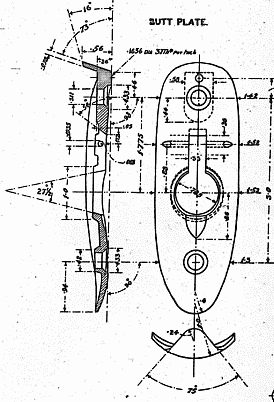 .......
.......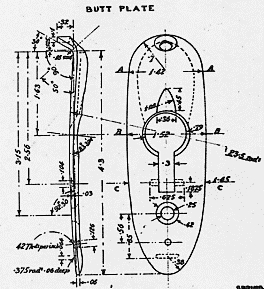
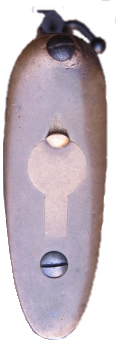
The drawing no. 2322A of alternative components, (which superseded the first numbered 2322), also illustrated both the specifications for the chequering on the wrist of the higher quality special finish ( latterly known as the "DeLuxe" rifles ) along with the plans for the military style "lengthened fore-end" shown as the upper rifle in the very first image on this page.
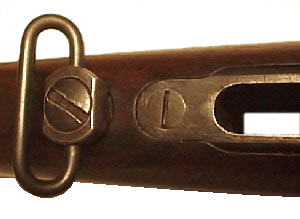 BSA designed a centre
sling-swivel for fitment in place of the standard rear bedding screw. This
came about as a result of the initial intended use of the rifle for target
shooting. However, whilst the performance of the W.O.P. rifle was adequate
for basic training, it was soon totally outclassed by B.S.A.'s subsequent designs; particularly that of the B.S.A. Model No.12 Martini actioned rifle, but even by the more simple and cheaply priced
rifles such as their Model No.1 and Model No.2 dual-purpose sporting/target rifles.
BSA designed a centre
sling-swivel for fitment in place of the standard rear bedding screw. This
came about as a result of the initial intended use of the rifle for target
shooting. However, whilst the performance of the W.O.P. rifle was adequate
for basic training, it was soon totally outclassed by B.S.A.'s subsequent designs; particularly that of the B.S.A. Model No.12 Martini actioned rifle, but even by the more simple and cheaply priced
rifles such as their Model No.1 and Model No.2 dual-purpose sporting/target rifles.
This basic design of sling swivel was the precursor to those used on both the S.M.L.E., and subsequently on the Lee-Enfield No.4 rifle and its sniping version the No.4T as combination trigger-guard bedding screw and sling-swivel mount.
Left: the patent free rotating sling-swivel
fitted in front of the magazine way
on the
Right: the January 1907 patent for the swivel,
subsequently, in one form or another, a familiar fitment to many a British Service rifle.
Image by courtesy of the Trustees of
the
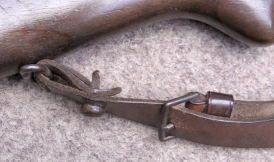 The
rear / lower sling swivel can be seen, left,
The
rear / lower sling swivel can be seen, left, 
with the most commonly used leather sling attached,
with the stud and tie reminiscent of that seen on
early full-bore Enfield service rifles
Below is the Royal Small Arms Factory drawing no.2232A of the "Alternative Components" for the rifle.
These include both the DeLuxe chequered woodwork and the military full-length fore-end
offered as later production options each previously discussed and illustrated.
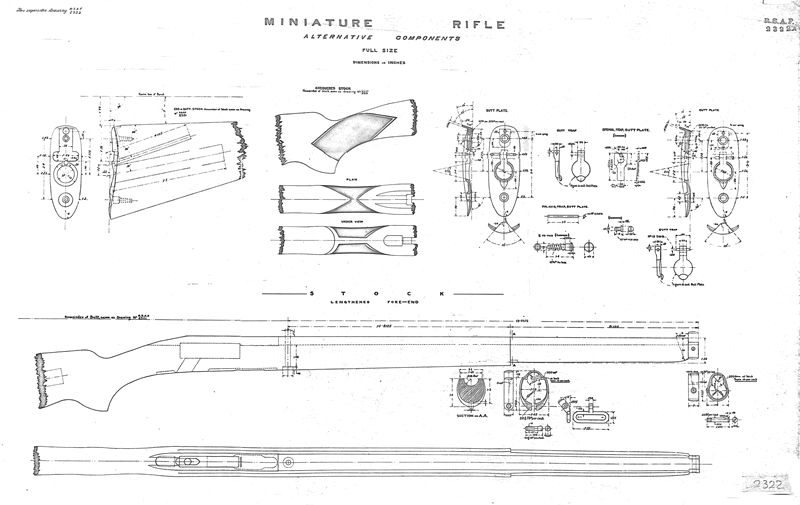
Image of drawing copied in sections by courtesy of the Trustees of
the
We hope to be able to bring you the main drawings for the production rifle in due course,
with the kind assistance of the staff of the Enfield Pattern Room at the Leeds Royal Armouries.
Again by kind permission of the Trustees of the Imperial War Museum,
we can show you the R.S.A.F. drawings of the 5 round production magazine and its components.
_________________________
There has been little mention thus far of the War Office Miniature Rifle in .297/.230" Morris calibre so, to correct that, we show an example that was originally a B.S.A. single-shot full-stocked military-style model that an owner long ago decided to cut back to near standard trim, but necessarily retaining the front barrel-band.
Hover over or Click image to bring up hi-res file and magnifier
This rifle too has been fitted with a London Small Arms eccentric folding rear aperture sight. The fore-sight hood has also been removed.
A stacked set of images of the bore show that the rifle's rifling remains in passable condition.
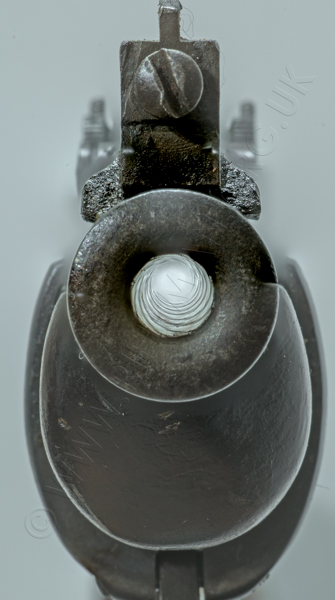
The barrel marks on the Morris rifle carry the last line of calibre
" CARTRIDGE .297/.230 LONG "
There is no date alongside the "BIRMINGHAM" mark,
and th RHS of the receiver ring carries the proof mark and calibre mark "230L"
The patent number stampings are the same as those of the .22RF rifle.

Left below: the significantly larger diameter chamber shows how tight the Morris rounds rim in the bolt-way. The extractor, and therefore the slot, is slightly larger than that for the .22 LR.
Right: the boltway appears little different from the .22RF model, and the reinforce includes the gas vent slot.
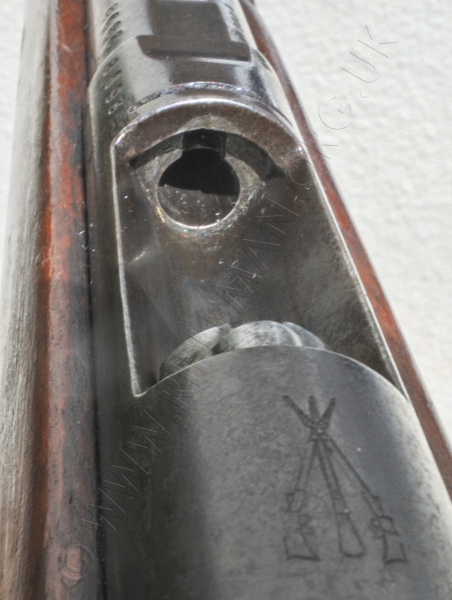 .........................
......................... 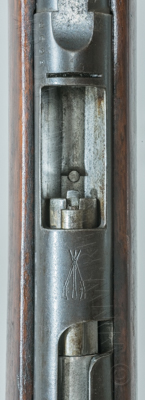
However, the bolt-head has the larger recess for the wider head of the Morris cartridge case, and shows the greater diameter hole for the round centre-fire firing pin.
To the right is a Morris Long cartridge to approximately the same scale.
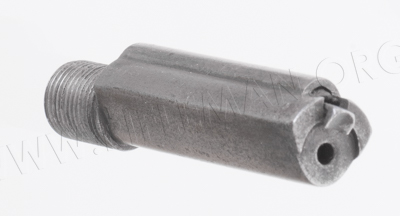 ..........
.......... 
The disassembled bolt with the one-piece firing pin - similar to the configuration of the .303" Lee-Enfields, except that the forward section is shouldered, not tapered, to the striker.
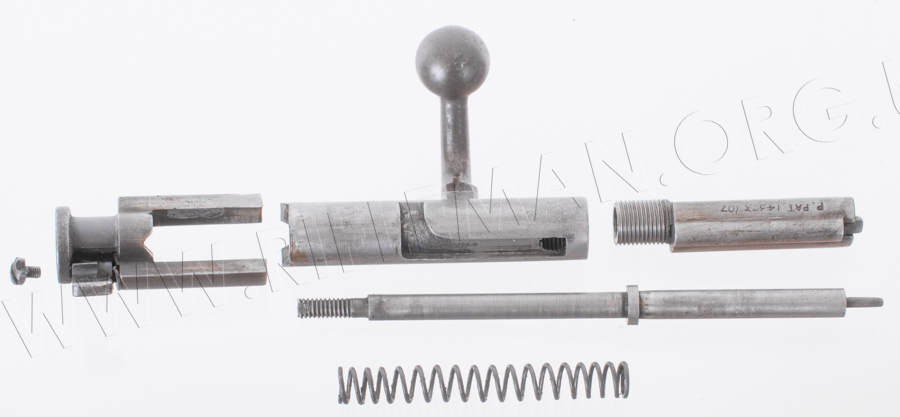
The rear-sight shows no apparent difference from the .22RF rifle,
and the range calibrations between 25 and 200 yards are unchanged.
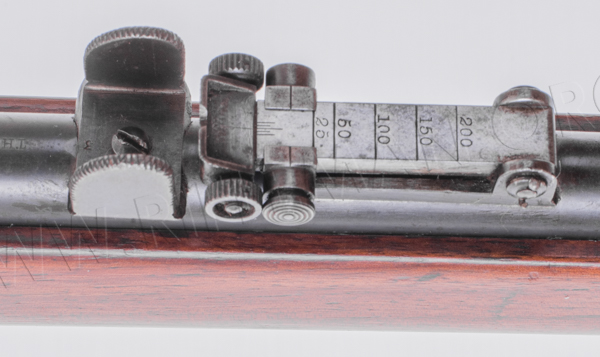
_____________________________________________________________
BSA produced a fine hardback
"HANDBOOK for the WAR OFFICE MINIATURE RIFLE"
The original burgundy card covered books are increasingly difficult to find,
and none too cheap at that.
Facsimiles are available, but not always of the best reproduction.
We provide here a replication of the handbook for all to read FOC.
This can be viewed as a text-searchable flip-page document
or with vertical scrolling by clicking the portrait icon.
Depending upon the number of pages it may take a few moments to load.
Double tap tablet or click ![]() for full page display.
for full page display.
So well used were many of these rifles that, as early as 1916 - only ten years after their introduction, Parkers were offering Parkerifled refurbished rifles, as in their advertisement printed in the SMRC journal "The Rifleman" in June of that year.
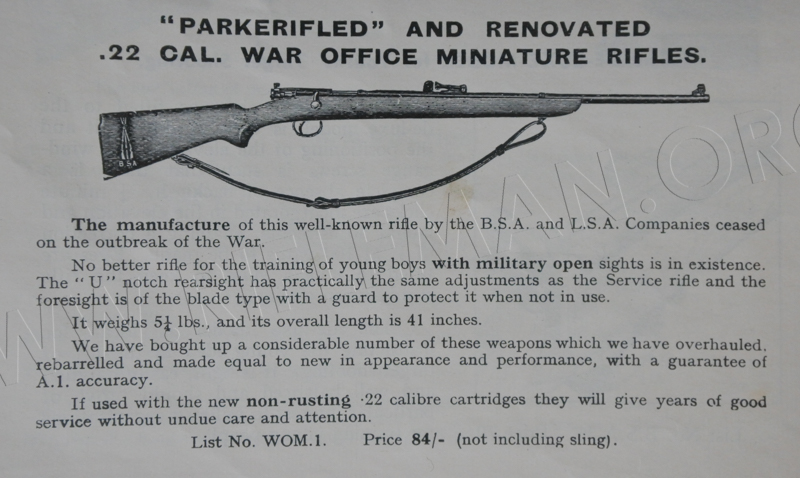
Considerable quantities of the rifles having been bought up from sources as yet unknown to us, the refurbished models were available for just 84 shillings, which was just four pounds and four shillings, or four guineas.
With a recommendation that the rifles be used with the "new" non-rusting cartridges, years of good service were promised "without undue care and attention"!
HOW OWNERS WERE ADVISED TO
"LOOK AFTER YOUR MINIATURE CALIBRE RIFLE"
The cleaning equipment that would be expected to have been accommodated within the butt trap of these rifles
was partly indicated on a R.S.A.F. Drawing No. 2321A (of the DeLuxe model) which carries a component section
illustrating the Mark IV brass oil bottle - the standard service rifle issue of the day.
Whilst the butt-plate is itself smaller than that of the service rifle it emulates,
the trap is actually of a similar configuration, and will take the full-size bottle.
Additionally, A.G. Parker could supply an after-market pull-through with a brass drop-weight
usually with a bristle brush on the business end, and a wire loop to take a .22 flannelette patch.
This kit is illustrated below.
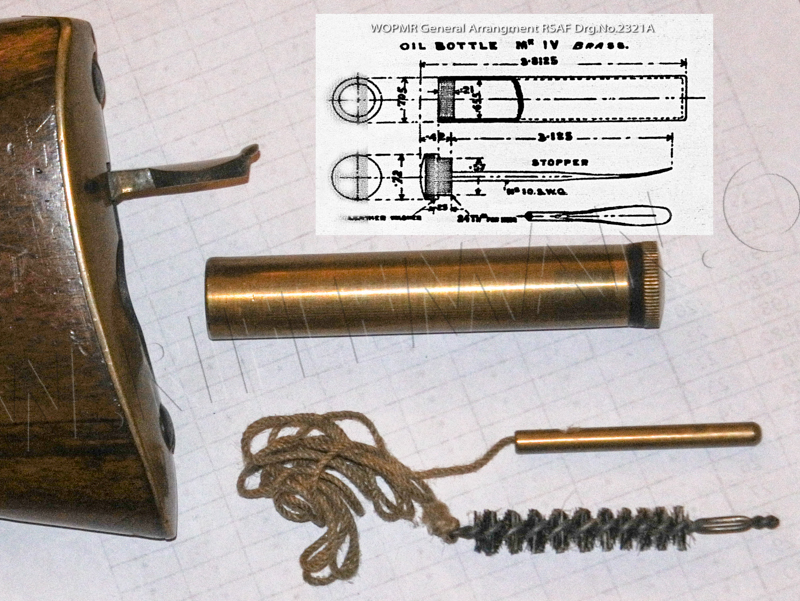
A contemporary look at what was available can be taken in various A.G. Parker catalogues of the day.
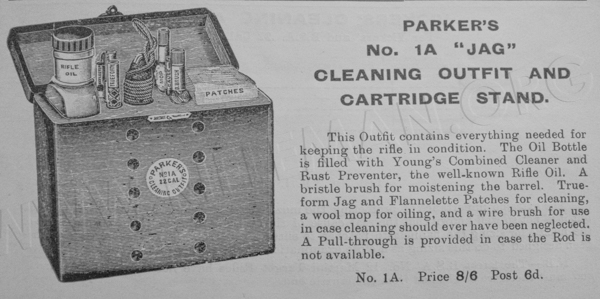
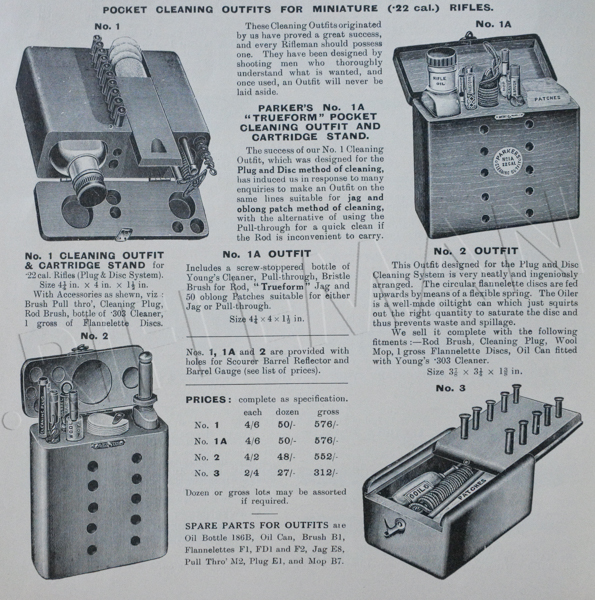
Some outfits could even include a mirrored bore viewer,
the equivalent of those available for the full-bore .303"CF service rifle.
This diminutive unit could be used with either the Martini falling-block
or with bolt -action miniature-calibre rifles.
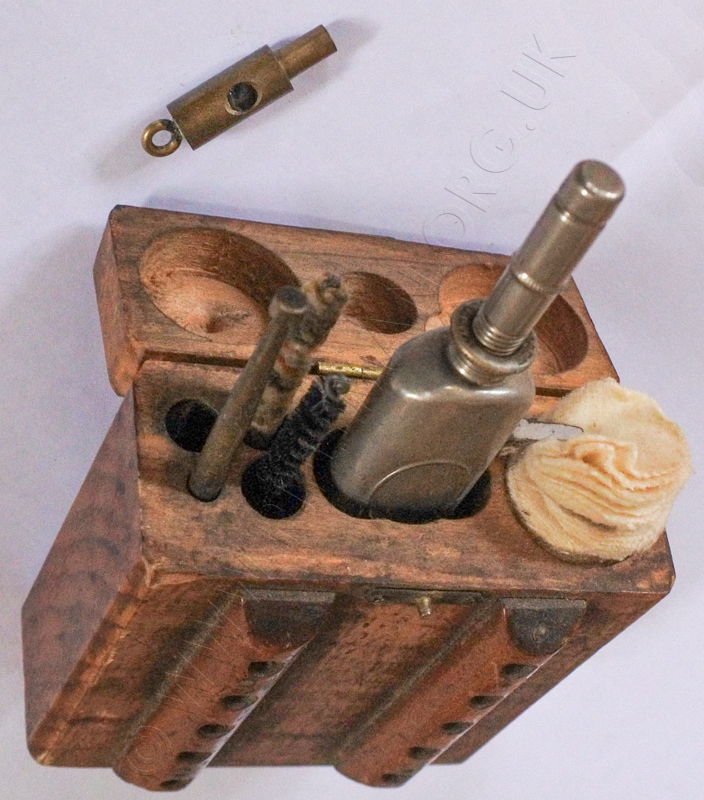
There were several types of separate .22 calibre pull-throughs available,
often in convenient leather pouches, at quite reasonable prices even for the time.
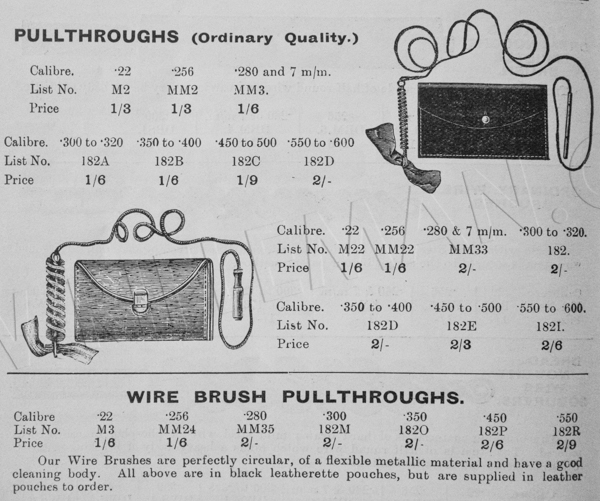
The Birmingham Small Arms Company produced a small booklet on rifle cleaning,
which can be viewed in its entirety as a flip-page document here -
BSA Notes on Rifle Cleaning-1912
Further to the reputation earned by the W.O.P. rifle,
we include some contemporary comment by some famous shooting pundits of the day.
The latter of these reports, by Ernest Robinson, can be described as little less than damning!
L.R. Tippins, in his 1910 edition of "The Rifleman's Companion", wrote honestly and fairly as follows:
" The War Office miniature is a boys' rifle in its essential
features. It is not a bad rifle, especially with latest improvements, which
were, however, very much needed. No makers, and few vendors, have yet succeeded
in making any profit on it. A better rifle, in the writer's opinion, on the
same lines, is the B.S.A. bolt rifle, at a lower price. It is generally acknowledged
to be the best value at the price ever produced.
The best rifle for members of the service, is
a service pattern -22, fitted with sights for service and for Bisley.
This will do more than anything else to teach the rifleman to handle the service
rifle; but he must remember that the recoil of the service rifle introduces
a further problem, and his hold should be firm and consistent, and not allowed
to degenerate into loose and lazy dandling. The same rifle may be fitted with
match sights, and used for preparation for match rifle work.
The American rifles are very popular, especially the Stevens Ideal. It
is not, in some respects, as good a rifle as the
In the first edition of the edition of "The Citizen Rifleman" in 1906, when the W.O.P. rifle had barely " hit the streets", E.J.D. Newitt, commenting factually on the inception of the rifle and its specification, wrote:
"In 1895 the French Government issued
a manual for the instruction of pupils in the primary schools, and this has
since been systematically carried out and the results very favourably reported
upon by the Minister of War. Annual Government grants to enable the schools
to provide rifles and range appliances have been made for some years past,
the practical utility of which is evidenced by the fact that this grant is
increased in amount every year.
In the latter part of 1905, a Committee of the British War Office, assisted
by representatives of the National Rifle Association and Society of Miniature
Rifle Clubs, met for the purposes of determining the details of a low-power
rifle to meet the requirements of Civilian Rifle Clubs, schools and other
organisations for teaching marksmanship in England.
' In 1906 a complete specimen, constructed at the Government Small Arms
Factory at Enfield, was adopted, sealed as a pattern, and is now in course
of manufacture by the Birmingham Small Arms Co. and the London Small Arms
Co.
The calibre is .22, and the pitch of the rifling is suited to the .32-5-40
cartridge. The bolt action is similar in appearance and operation to that
of the British Service rifle. The stock has a pistol grip and a short fore-arm,
terminating about eight inches from the muzzle. The weight is 5 lbs. 5 ozs., the
barrel being tapered towards the muzzle, and somewhat thinner and lighter
than the best examples of American .22 calibre rifles.
The sights are of military pattern, the backsight permitting of vertical adjustment by means of a slide resting upon an inclined
ramp, and of lateral adjustment by means of a screw. The front sight, owing
to the tapering of the barrel and height of the back-sight, has a total height
of three-quarters of an inch, the point being protected by a neatly designed
hinged cover. The radius between the sights is 18 inches. The Continental
system of long pull or draw trigger, and swivels and sling similar to those
of the Service arm, which this rifle resembles in miniature, have been adopted."
Immediately post the First World War (1914-18) , there was absolutely no mention of the War Office Miniature rifle
in the then new edition of "The Citizen Rifleman"
Just prior to the Great War (1914-18), two British officers, H. Ommundsen and E.H. Robinson, wrote the famous reference book "Rifles and Ammunition".
Lt. Ommundsen was killed early in the War, but Ernest Robinson survived to continue penning a number of rifle training books, including " Rifle Training for War" which he first published in 1914 and re-edited, as Captain, for later publication in 1940 during WWII. He was destined to become, at Bisley in 1923, a winner of the prestigious " King's Prize" for rifle shooting.
In "Rifles and Ammunition" in 1915, they wrote of the miniature rifle scene as follows:
"In 1904 the National Rifle Association
and the Society of Miniature Rifle Clubs held a meeting in conjunction at
By the end of 1905 the civilian rifle movement
had got such a hold on the country that the War Office became actively interested,
and decided to seal a design to be known as a cadet rifle, to be used by Cadet
Corps, Rifle Clubs, and similar organisations. The War Office called to their
assistance experts from the N.R.A. and the Society of Miniature Rifle Clubs,
and apparently they started out with the very best intentions in the world.
The rifle was to shoot the .22 cartridge, and was to cost about 30 shillings.
When it was known that the War Office was going to help by the turning out
of a cheap and really efficient rifle, the rifle club members were in high
glee. But bitterly were they disappointed when the completed article came
out. The War Office miniature rifle was doomed to failure from the start.
It shot quite decently, because it was manufactured by the Birmingham
Small Arms Company and the London Small Arms Company, who know how to manufacture
rifles to shoot well, but the design passed by the War Office will not permit
of the rifle being sold at less than 45s. or 55s. fitted with magazine to hold five cartridges, whereas there
were already several excellent rifles on the market at about the same price.
The War Office miniature rifle was too light for ordinary use, as 5 lbs. will
not give sufficient steadiness for the best shooting. The hollow form of the
rifle was expensive, with many unnecessary refinements. A little later the
Birmingham Small Arms Company showed what could be done by turning out a bolt-action
rifle, the bolt of which was very similar to the War Office miniature bolt,
at a price of 30s. Despite the activities of the War Office and some of the
big firms, the real boom of the civilian rifle movement did not come until
a genius in the gun trade had discovered that it was possible to convert old
Martini-Henry rifles to fire the .22 bullet. Who this genius was it is difficult
at this date to say.
To that well-known gunsmith, Mr. W. W. Greener, is usually given the credit
for first showing that these old rifles could be fitted with new barrels,
bored eccentrically so that the old striking-pin could be utilised for detonating
the primer of the rim-fire cartridge. Once the idea had taken on, the conversion
of Martini-Henry rifles went on apace. The Society of Miniature Rifle
Clubs and the National Rifle Association secured from the War Office the right
to convert these weapons and to sell them at 25s. to members of clubs affiliated to them. The converted Martini, as it was called,
is the most excellent cheap rifle it is possible to obtain. It is of correct
military weight in nine hundred and ninety-nine cases out of a thousand, and
it shoots well enough to put ten shots in succession into a half- inch carton
at twenty-five yards. It is not easily damaged, and, in fact, it fulfils all
the ideals of a rifle club weapon. "
Fifteen years later, in 1930, Capt. Robinson, G.M., reminisced on the War Office "Miniature" in his new book " Rifle and target". He then said:
"British small-bore rifle manufacturers use exclusively the "miniature Martini" action, which was first developed in the Martini Francotte "carbine" which old hands will well remember as something of a favourite in the early days of the small-bore game when accurate "twenty-two" rifles were difficult to obtain in this country. Talking of the old days, it is somewhat curious to remember that the small-bore rifle, despite a rapidly growing popularity, and despite every effort to set up ranges in every city, town and village in the country, was regarded by Authority as essentially a weapon for boys and youths. Hence this rifle was commonly called a carbine or labelled "Cadet," and hence the ridiculous "War Office Miniature Rifle" which appeared with a Government blessing in 1906, which was greeted with howls of derision, even in those days, and which was probably the worst small-bore rifle that has ever been designed, though most British riflemen will agree that the more recently issued U.S.A. Springfield (1926) .22 rifle runs it very close in general lack of suitability for the work, though it is not, like the War Office miniature, so light that a puff of wind would blow it away. Small-bore shooting is not a military game and any attempt to build a small-bore rifle on military lines is bound to result in failure. This does not mean that the .22 cartridge is not the best and cheapest thing to use to teach military shooting; but it does mean that for military work it should be used in the full size military rifle fitted with a suitable barrel."
Published in 1906, the book "Modern Sporting Gunnery" by Henry Sharp included a chapter on miniature rifles. Within that chapter he made mention of the coming Government miniature rifle, and wrote as follows
"The War office has produced its own model of miniature rifle, of which I understand the bolt, fore-sight protector and back-sight are all of Government design. The other items have been selected from six competing models which were submitted by gun manufacturers, whose sole reward, I am informed, lies in the honour of contributing ideas which are regarded as unpatentable combinations. Had these gunmakers been responsible for the whole effort, they would not have had much to boast about.
This miniature rifle is very much on the lines of the American small-bore rifles, already alluded to and so familiar here during many years, having the same pitch of rifling, and shooting an American cartridge of .22-bore.
This Government miniature rifle is on the bolt principle.
Length of barrel, 24 inches.
Length over all, 41½ inches.
Weight, 5 lb. 5 oz.
Bore, .22 for long cartridge, rim-fire.
Charge of powder, 5 grs. semi-smokeless.
Weight of bullet, 40 grs.
Length of cartridge, 31/32nds., of an inch.
Length of case, 39/64ths., of an inch.
Weight of cartridge, 55 grs.
It is sighted to 200 yards, which is an extreme range for the long '22 cartridge, and is principally intended for indoor use at 25 yards, and also for shooting up to 100 yards, in this respect confirming the mistaken policy adopted by the National Rifle Association with regard to the range for miniature competitions.
The best feature of the weapon is the back-sight. It is of the flap-up pattern similar to the new service sight, and has a wind-gauge bar, though of an antiquated pattern. The Westley Richards sight of this pattern is far superior and of more mechanical construction.
This new Government weapon has not yet been subjected to a thorough test, but it may prove successful within its limit. If produced cheaply, it may have a demand, but the civilian who takes rifle-shooting seriously is more likely to prefer one of the superior rifles of large calibre and longer range which I have described.
In a small but very instructive pamphlet, entitled The Art of Shooting with the Rifle, published in 1888 by the late Sir Henry Halford—who gave a life-long devotion to the art of rifle-shooting —we read at the conclusion of his work—
"I shall be well repaid for my trouble if I can induce one Englishman to become a rifleman. Believe me, the use of the rifle is a sport in itself. More than that—and far more-- the rifle of the present day is the long-bow of the middle ages. If the youth of England could use the rifle, the strength and power of the United Kingdom would be invincible."
When this experienced rifle-shot uttered these words, he was only foreshadowing what we all hope may be the outcome of the civilian rifle movement."
The whole of this informative piece is available via this link - Miniature Rifles by Henry Sharp.
Next in our presentation, shown below are three articles (two photo reproductions and one text), taken from the S.M.R.C. journal, "The Rifleman" in April, September and October 1906, heralding the War Office Pattern rifle which had been so much talked about and eagerly awaited. Each article relates a view on the introduction and specification of the 'new' rifle. Much relevant information can be derived from careful perusal of these pieces. Interestingly, the earliest, April 1906, piece illustrates the magazine-fed rifle, whilst later in the year it is the single shot version which is described.
" THE NEW STANDARD MINIATURE RIFLE - APRIL 1906 "

"THE WAR OFFICE MINIATURE RIFLE, .22 CALIBRE - SEPTEMBER 1906
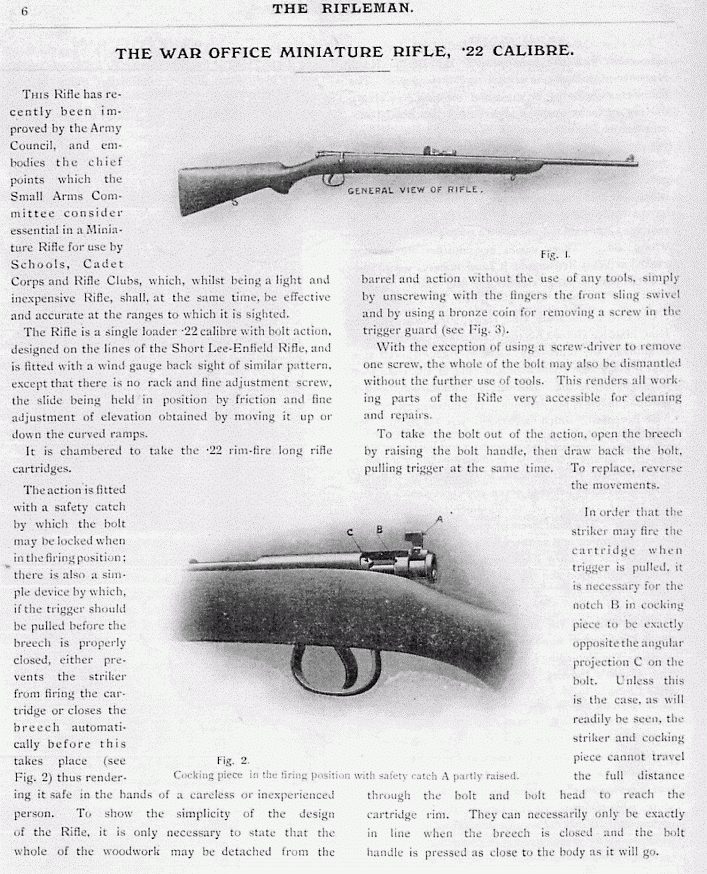
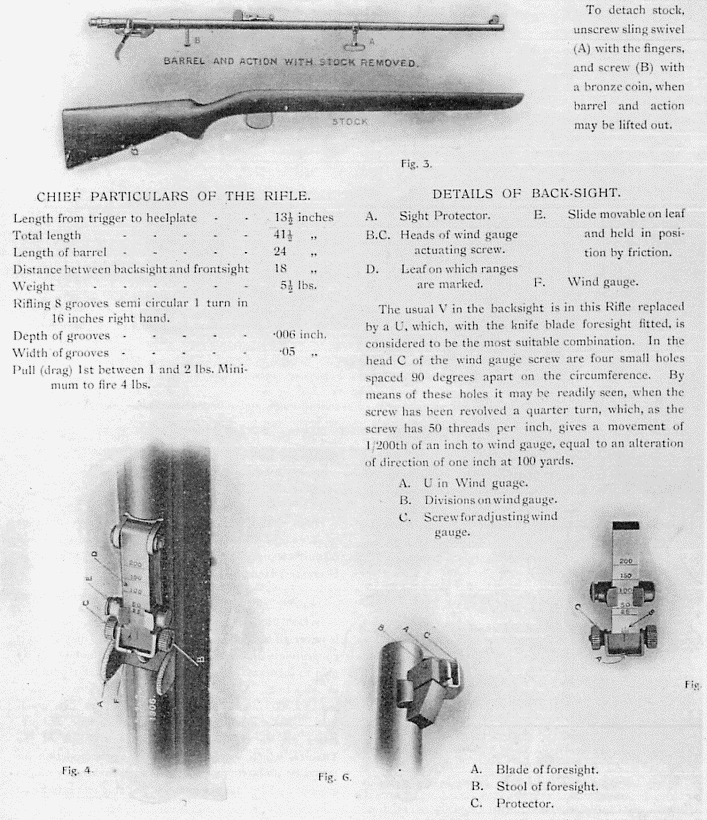

In October 1906, Lieutenant Colonel Burgess wrote the following piece on the "War Office Miniature"
with informative notes on a number of its contemporaries.
"NOTES ON MINIATURE RIFLES, &c.
The War Office having adopted the .22 calibre
rim-fire cartridge for its new standard miniature rifle, a few remarks on
this may be of interest.
The ".22 " Long Rifle " cartridge having a bullet of 40grains,
driven by 5 grains of black powder, is very accurate, though of course with
a high trajectory to 200 yards, to which range the new standard rifle is sighted.
The "'.22 Short " cartridge, which can also be used in rifles
chambered for the -22 " long rifle." has a 30 grain bullet with
a 3 grain powder charge. It is extremely accurate to 50 yards, '(the "
"22 conical bullet cap" (C.B.C.) which is only the "22 short
with a shorter case and lighter charge, is also very accurate to 20 yards.
All .22 R.F. cartridges loaded with black powder are very reliable if
of one of the well known American brands, such as the Winchester, U.M.C,,
and Peters, but with black powder the folding requires frequent wiping out
of the bore. I am not sure that the smokeless are equally reliable - they
certainly were not when first introduced.
Rifles specially bored and chambered for the .22 short cartridge shoot
better with it, but it is convenient to have a rifle to carry all the three
kinds of ammunition, It would make little difference except perhaps in the
hands of an expert.
.22 CALIBRE MINIATURE RIFLES
The War Office Pattern rifle has a bolt action manipulated like the service
rifle ; it is also fitted with a small box magazine, which can also be attached
if required, holding five rounds. The sights are not unlike those of the new
short service rifle and are graduated to ranges of from 25 to 200 yards; they
are fitted with a wind-gauge arrangement. The rifle has a 25-inch barrel and
weighs about 5lbs.
There are many other cheap and reliable .22 calibre rifles, mostly of
American Make. The .22 single shot
Winchester, 1900 model, bolt action rifle, is a very accurate little weapon,
its cost is only 21/- (shillings). A later pattern of this rife, weighing
a pound or so more (with a heavier barrel) can he had for a few shillings
extra; it would give better shooting of course. The .22 single shot Stevens,
bolt action rifle, costing about the same, is also a very reliable arm. The
same may be said of the .22 Savage bolt action single shot rifle, which, in
action, worked by an under lever, and a detachable barrel, it is heavy enough
to give steady shooting and is very accurate. The cost is about 30/-. The
accurate. Their price is of course considerably higher. There are many
.22 calibre repeating rifles also which shoot extremely well, but I do not
see the necessity of a repeater for target practice. Several English gunmakers are now turning out reliable .22 calibre rifles
at a moderate cost from 42/- upwards."
With regard to the introduction of the magazine-fed rifle, it is relevant to note that, in the following Army and Navy Stores Catalogue entry of 1907 the "repeating" option was still "in the course of manufacture" and implied that it should soon be available and that orders should be passed without delay.
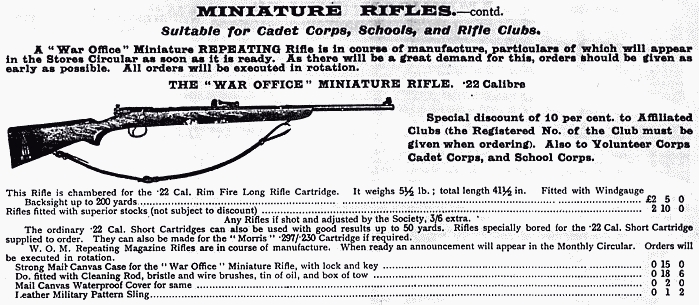
The many proud owners of these more than a century old rifles World-wide should not be disheartened by the adverse comment written by W.W. Greener in his 1908 book "The British Miniature Rifle", a the section of which is replicated in the following PDF. It, of course, represented an opinion of the rifle in its nascent time on the market, and many of the faults discussed were later corrected, resulting in an accurate and effective lightweight rifle for youth and ladies.
As a Post Script, we leave you with a copy of a late 1906 advertisement by the London Small Arms Co. Ltd., for their version of the W.O.P. rifle, proudly publicising successes achieved at the main Miniature Rifle shooting meetings of the year. Ironically, the claims are not for the "War Office" miniature rifle, but for their miniature calibre service rifles in the form of the obsolescent "Long" Lee-Enfield. Sold commercially, such expensive rifles - at nearly twice the cost of the W.O.P.rifle - would not have been conversions per se, but rifles newly built using new spares. Such rifles bear no military markings, usually only the manufacturer's own company marking on the right-hand side of the butt socket. The superior finishing of the metal and woodworking is often a give-away in this respect. Whilst originally fitted with purpose manufacture solid .22" calibre barrels, many such rifles have been "Parker-Rifled" in later years. One so fitted, and having been carefully cleaned and cared for, will still shoot to a significant degree of accuracy, certainly within a group of half an inch at 25 yards in the hands of a competent shot.
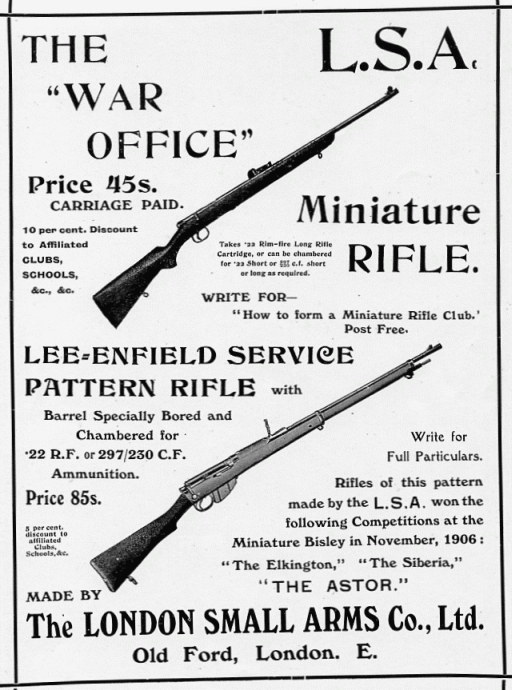
The single extractor bolt/action, barrel markings and butt-stock cartouche of an early 1906 London Small Arms version of rifle are shown below for comparison with the BSA marks.

It will be seen that the patent registration no.475418 is identical to the BSA markings, as would be expected.
The Government stamping of the Crown with " MIN. RIFLE - W.O. PATT." ( Miniature Rifle - War Office Pattern)
is also common to the rifles of both manufacturers
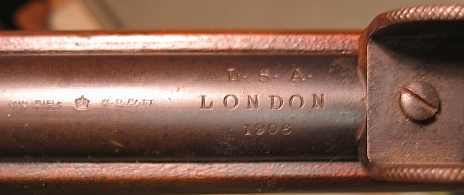
The cartouches, LSA to the left and BSA to the right, are shown here near actual size.
LSA put their logo onto on the right-hand-side of the butt, as with either of the two leftmost images, whilst BSA traditionally placed their more familiar "piled arms" trade mark onto the left-hand-side of the butt, as the right-hand image.
 ........................
........................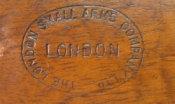 .........................
.........................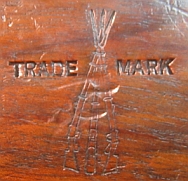
Below is a facsimile of the 1906 London Small Arms Company
brochure for the War Office Miniature rifle.
Yes, it is from a very poor photocopy, although the interior pages are good.
Should you have better imagery we would be grateful for copy.
The document is illustrated in the form of a flip-page booklet.
A point worthy of mention is that these rifles were owned and used by those at all levels of society.
The National Maritime Museum at Greenwich (London) holds, in its firearms collection,
a BSA 1908 manufactured War Office Pattern Miniature rifle (believed serial no. 5340) originally owned
by Admiral Lord Cunningham (born 1883 died 1963).
During his illustrious career, Lord Cunningham was Admiral of the Fleet,
Commander-in-Chief of the Mediterranean Fleet, August 1940, and served as First Sea Lord between 1943 - 1946.
In relation to dating and
serial numbers, David Penn, then Keeper of Weapons at the Imperial War Museum,
wrote to an enquirer
from the H.B.S.A.
(The Historical Breech-loading Small-arms Association) that:
"When I started looking into W.O. Miniature Pattern rifles some years back, I came to the following conclusions:
Both B.S.A. and L.S.A. Co. started their serial ranges at 1.
I have seen LSA Co. rifles with
date marks between 1907 and 1911, and with a high 1911 serial number of 4,855
that indicates average production of less than 1,000 a year. To confuse the
issue, however, I have a report of a LSA Co. single shot rifle dated 1913
with a serial number of 2,480, which I have not examined. I suspect that LSA
Co. had a separate serial range for its magazine version, as number 24 is
held in the Imperial War Museum collection.
BSA seems to have stopped putting a year of manufacture on its W.O. Miniature
Pattern rifles in 1911 (I have not come across one that is later), by which
time its serial numbers were in the 8,000 range. By 1914 or early 1915, when
production I think ceased, the highest serial number that I have found was
21,505. [Our survey now updates that highest serial
no. to 21,908 - Ed]. The rifle was still being advertised in the
1914 A.J. Parker catalogue.
The information on these pages is obtained from best known available sources.
If you have details to add, or are aware that anything we have mentioned is in error, then please let us know.
Additionally, we are carrying out a survey of rifles with respect to the relationship between manufacturer, serial number and date of manufacture to enable more definite reporting of such subjects for readers' benefit. If you own or have access to one of these rifles, we would be most grateful for such information. We have tabulated (link below) a reference table to illustrate what we are trying to acheive. We are frequently asked to provide owners with an accurate date for the manufacture of their new acquisition or family heirloom, and this is the means to that end.
or CLICK HERE TO VIEW THE DATA TABLE & SURVEY DETAILS
A notable continuation of the the B.S.A. company's work on the War Office Miniature type rifle
involved experimentation with a larger calibre capable action.
These photographs have been taken by 'Rifleman' with the kind permission of the Royal Armouries.
The Royal Armouries National Firearms Collection holds such a rifle (object no. PR5880) configured with a twin-lugged forward-locking bolt. The rifle carries no visible serial number, but has the patent no. 25157 stamped on the left-hand-side at the rear of the receiver.
This rifle is in .230 Long calibre (Morris .297/.230 - inch)
and remains in the early 1906 Pattern style with its military-length stock.
The action was also specifically designed to permit the addition of an aperture sight at the rear of the receiver body.
The barrel and receiver are machined in one piece, as that of the standard War Office Pattern rifle.

The specially designed boltway, described in the patent shown further down this page, can be clearly seen in these images, along with the twin forward locking lugs.
The loading platform is spring steel dovetailed into the receiver at the rear and curved up towards the base of the chamber. The spring is driven down by the leading edge of the closing bolt feeding a round into the chamber.
See the following patent drawing.
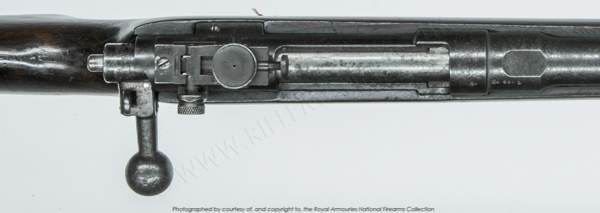
The patent no. 25175 stamped at the rear of the action was dated 13th. Nov. 1907 (in the names of Messrs. Driver & Norman of the B.S.A. Co.), which application relates to a bolt-head positioned to pick up a cartridge from the single-loading sprung 'raceway' that is slightly below the bore-line, to facilitate loading by allowing a cartridge to be simply dropped into the bolt-way, with the closing of the bolt lifting the nose of the bullet into the chamber.
This arrangement is not unlike that of the standard War Office Pattern rifle, with its channelled bolt-way, but that rifle's loading platform is level with the chamber and the bolt-head is of an appropriate cross-section, not requiring a sprung loading platform. The experimental rifle's design enables a circular bolt-face to be used, rather than the standard rifle's bolt-head, which is tapered beneath to the shape of the bolt-way. The experimental rifle's design permits the use of cartridges with greater gas pressure.
The action body was designed to afford the mounting of an aperture sight at the rear of the receiver. The NFC rifle carries such a folding leaf sight, which appears to be to Driver and Norman's patent no. 26,943 of 6th. December the same year.
The patent is replicated below.
The first two images below show the sight folded down,
and the third from above when raised.
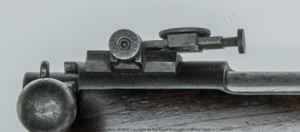 ....
.... 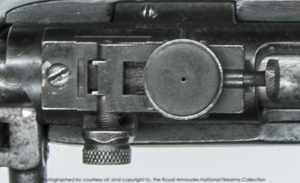 ....
.... 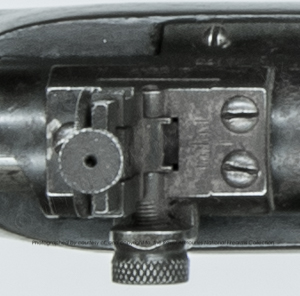
The rifle is fitted with both this folding-leaf rear aperture sight
and an unusual design of windage adjustable tangent rear-sight on the barrel
in a style reminiscent of that for the standard War Office Pattern rifle.
This rarely seen barrel-mounted tangent rear sight is illustrated below;
it is calibrated for elevation on the right side of the leaf frame's face
from 25 yards to 500 yards in 100 yard increments.
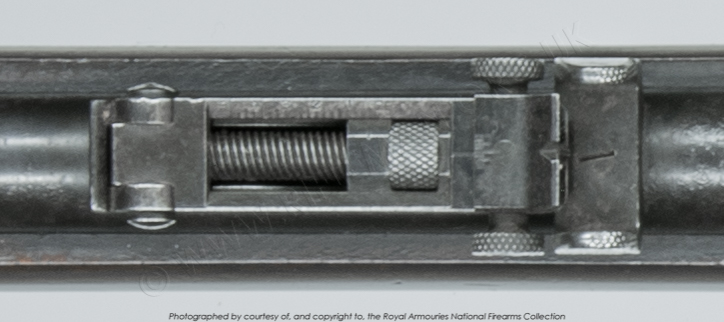
With the leaf lifted, the base beneath has the number "4" stamped between the protecting wings.
There is a definite possibility that this is also the serial number of the rifle.
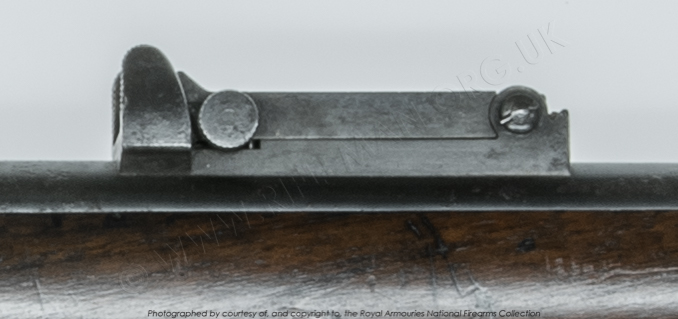
This tangent sight relates to two patent applications made two years prior to that for the aperture rear-sight,
being Nos. 14588 and 22681 respectively of 5th. July and 6th. November 1905.
The fore-sight, fitted on a sleeve over the barrel, rather than being dovetailed in, replicates that of the standard rifle,
but with the protecting hood having a spring-loaded locking button centrally within the knurled finger and thumb knobs that ease rotation.
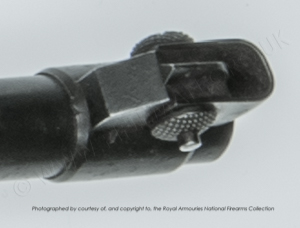 ............
............ 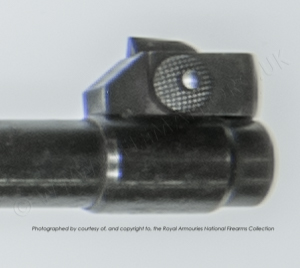
Closer images of the bolt show the one-piece construction
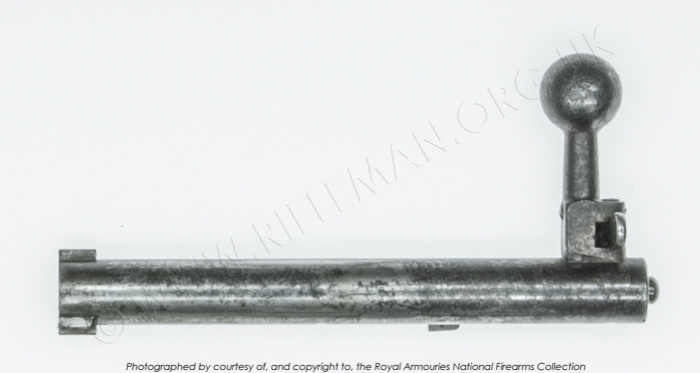
and the bolt-handle safety lever
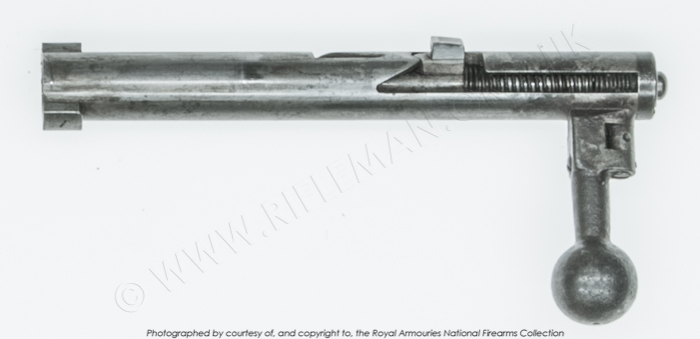
The barrel carries the date of 1908, and is marked
"MADE BY"
"THE BIRMINGHAM SMALL ARMS Co. Ltd."
"BIRMINGHAM"

The twin-lugged bolt design is to be found in their slightly earlier patent application of 6th. September - No. 19,941.
The bolt carries an unusual safety catch operated by a lever/tab sliding in a slot cut into the top of the bolt-handle near the bolt-body.
__________
We have been made aware of another similar B.S.A. made rifle, reported as being of .310" Cadet calibre, that carries the serial number "X01".
This photograph, and the others following, are shown by kind permission of Buck Stix in the U.S.A.

This is an earlier example, with patent pending,
and with the barrel being dated 1907.
It may well be the first of a very small number of these experimental models.

The serial number is stamped on the left-hand-side of the butt-stock and the rear of the receiver body.
It is a pity that the walnut furniture has been refinished at some point in the past, reducing the clarity of the cartouche, but at least the serial number was more heavily struck
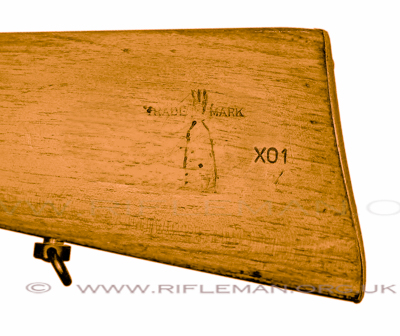
The latter mark appears to have been 'bounced' on each character by a careless craftsman,
leaving a hint of a double-struck set.

The twin lugged bolt shows clearly below.
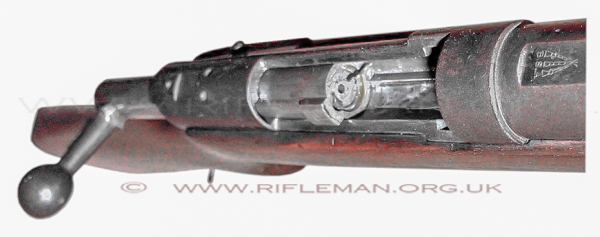
We wondered if this rifle had possibly been later 'sporterised', as the fore-end finishes where the middle barrel-band would probably have been, and a sling-swivel has been fitted about an inch-and-a-half back from that point. We had initially assumed that the sling-swivel was incorporated with a new bedding screw into the barrel in the usual manner of other half-stocked BSA products of the time; but in fact the barrel is bedded only by the two screws into the action body at either end of the trigger-guard plate. The knowledgeable owner assures us that there is no evidence that the barrel has ever been fitted with a band, and certainly most 1906 Pattern War Office Miniature rifles were of half-stocked configuration, albeit not with free-floating barrels.


The barrel is apparently in full contact with its groove in the fore-end wood all the way to the front, and it is difficult to know what to make of this in terms of certainty of how the rifle was set up when built in 1907.
This earlier rifle also has a gas vent on the left-hand-side just behind the receiver ring. This vent is not present on the NFC's rifle.
The arrangement of the safety varies between the two rifles, in that this earlier model has the slide catch at the rear of the bolt-handle rather than on top. The patent for this 'in handle' system is approximated in patent no. 13,170 catalogued for 1908, although the application shows as being on 13th, November 1907.
Compare the earlier safety catch of "X01" with that of rifle s/no.4 shown previously.
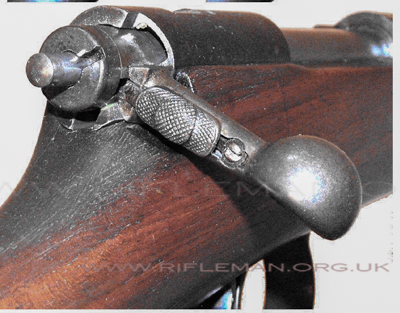
The disassembled safety of "X01"
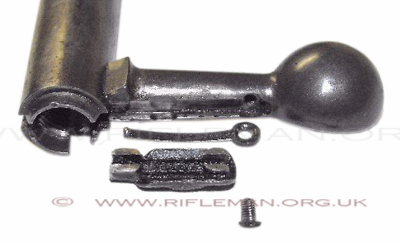
The action from beneath, and the trigger unit.
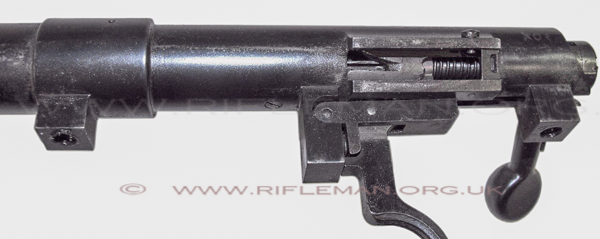
The breech, with its proud chamber rim that engages with the recessed bolt face.
The dovetailed fitment of the spring-steel loading platform is also evident.

The receiver image above shows the large lateral dovetailand three mount fixing screw holes that would hold the folding aperture rear-sight fitted to rifle serial no.4. This is missing from "X01"
The one-piece bolt from the left-hand-side.
The fore-sight is as that of the later of the rifle s/no.4, apart from the spring-loaded hood locking button being here out of sight on the left side.
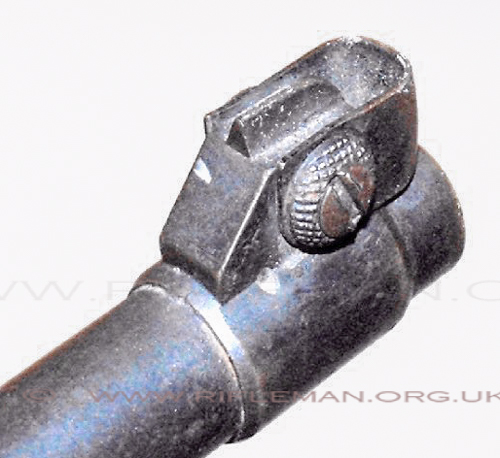
And, lastly, the butt-plate is the same as that used for the 1906 Pattern 'Miniature Rifle'.

Occasionally unusual examples of the production rifles appear, that, for one reason or another, we deem worthy of mention. One particular standard rifle recently (2024) came into the hands of an Australian owner from a colleague's estate. Noting from the barrel engraving that the rifle had been retailed by the Army and Navy Stores in London, the new custodian enquired of the holders of that company's records at Glasgow University, whether any data remained in their archive that would identify the date of sale.
The university's researcher found the rifle entry in the records by dint of its serial number, and revealed that it had been purchased in May of 1912 by a particularly famous First World War warrior: no less that H. Hesketh-Pritchard, the main instigator of the WW1 sniping schools, and author of the fine book "Sniping in France". The rifle is altogether a significant find, albeit not in the finest of condition; no doubt as a result of who-knows-what usage, and world-wide travel over the ensuing years. It would be good to discover how it found its way to the Antipodes.
We have been kindly afforded relevant photographs by the fortunate finder, as well as a copy of the pages in the Army and Navy sales ledger showing the record of sale - third from the bottom of the page - for rifle serial no. 12810. The confirming store's record number, 53467, is engraved on the trigger guard. The marks have been accentuated with white crayon.
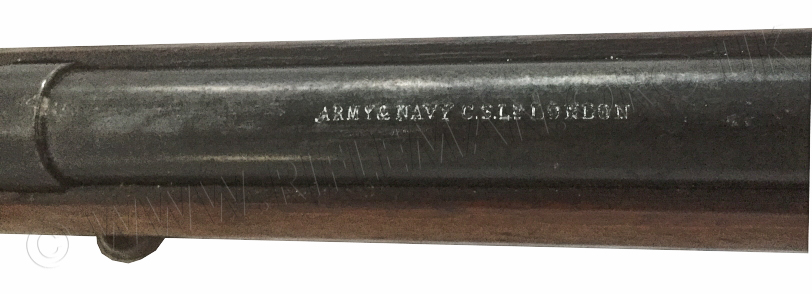

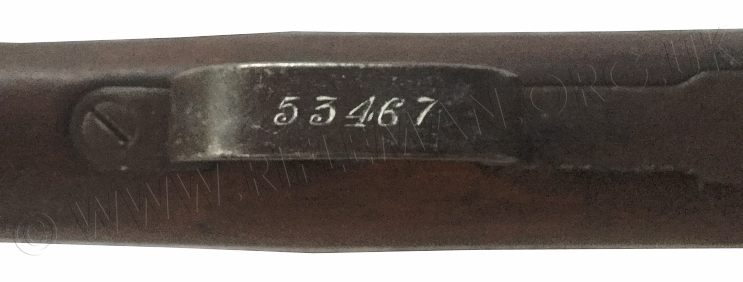
Hover over or Click image to bring up hi-res file and magnifier
Another unusual example hails indirectly from India, having allegedly been especially manufactured for the Calcutta base of the famous Mantons gunmakers of Birmingham.
The rifle was presumably purchased in the trade by Mantons, exported to, and retailed by their Indian outlet. In what way it was specially made for the company is a matter for conjecture; nonetheless, it is a handsome piece in its case.
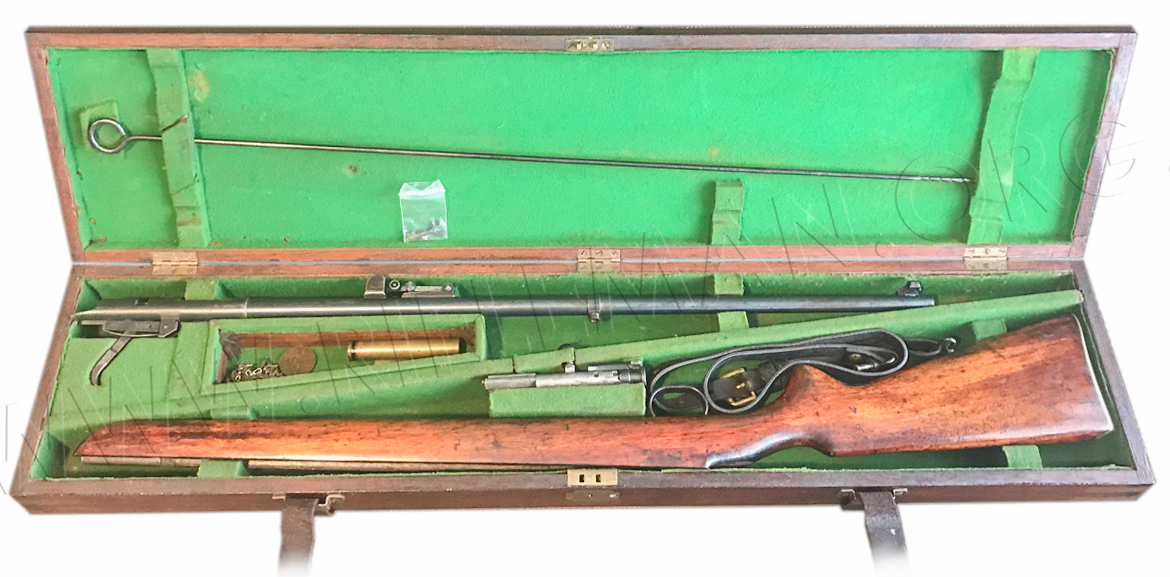

It so happens that the De Luxe BSA Model illustrated earlier on this page was also retailed by the Army & Navy Stores of Victoria Street in London, and it is here shown in its canvas case.
Hover over or Click image to bring up hi-res file and magnifier
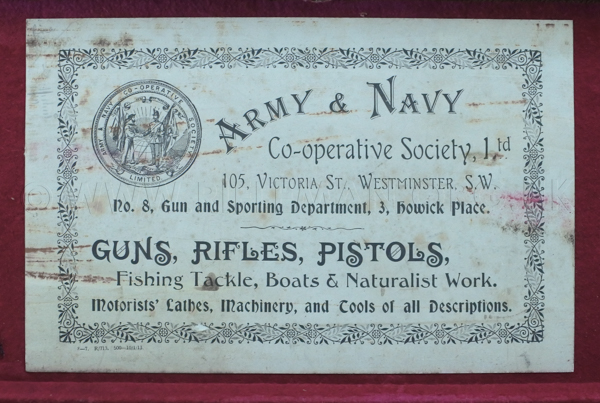
A rather sad footnote to the life of the War Office Miniature Rifle lies within a report made out in 1948 by an officer of the South African forces responsible for recommending the continued use, or otherwise, of the various training rifles in their inventories.
MEMO ON .22" RIFLES FOR TARGET SHOOTING
1. Rifles .22" B.S.A. No.12
These rifles were and are being used by school Cadets and also by the A.C.F. Units. Those only with the Cadets are being replacod by the Model 12/15 (see para 4) and will become surplus for that purpose but can still be used by the A.C.F. pending receipt of the No. 8 Rifle (see para 3). The total holding by the U.D.F. is 3000 of which 2665 are on issue and 435 In store. Cadet Detachments are in possession of 1962 and there are 703 in Command Stores.
2. Rifles .22" W.O.M.
This type of rifle is very light and of the bolt action type. They are most inaccurate and were all withdrawn from cadets for this reason. The stocks of this rifle are 332 serviceable and 113 repairable. I consider them of no value whatever to the U.D.F. and could be disposed of. 176 of this type are on issue and being used by the smaller boys pending receipt of replacemenst (see para 4).
3. Rifles No.2 Mark 4
This rifle is exactly similar in design to the No.1 Mk.3 Service Rifle and is used solely by the Forces for instruction in holding etc. Total holdings are 218, but difficulty is being experienced in the maintenance of this rifle. Quartermaster General has been requested to place an order for 300 No.8 rifles (in design like the No.4 Mk.1, the modern service rifle), but these have not yet come to hand. These rifles must be retained. Requirements are 573.
4. Rifles .22" B.S.A. No.12/15
The No.12 rifle used by the Cadets is being replaced by this type of which 1250 have been received. There should not be any held by any "7" Depot as Quartermaster General has been given the distribution for the total. The original replacement figure set was 3700 but after receipt of the 1250, Quartermaster General was requested to arrange for the balance 2450 to be of the lighter type, a B.S.A. Model No.13 of which 450 have been shipped from the United Kingdom. All of these two types will be required.
5. General
As and when the No.12 rifles are withdrawn from Cadets, they will be used, temporarily, for the shortfall of No.2 Mk.4 rifles required for the A.C.F. There will, however, be a number still surplus and I recommend that 60 B.S.A. Model No.12 fitted with No.30 Backsights and No.20 Foresights be released.
The original of the Memo of 22nd. July 1948 is shown below.

Ironically, the current listing of approved training rifles for the SSAA Combined Services still shows the War Office Miniature Rifle as complying, along with many other aged rifles covered by these web pages. The PDF entries are each linked to the relevant pages.
We believe we are justified in showing this PDF file, because it appears that a significant proportion of the data has been drawn from the pages of our website. The links are our own addition.
Zoomable PDF - Double tap tablet, or click ![]() for full page display.
for full page display.
Precise tapping of eack blue link line is necessary
An interesting snippet of Antipodean related War Office Miniature Pattern rifle information appeared in a recent newsletter of the Australian "Barrels & Blades" group.
The text, recovered from an early contemporary source, read:
..The official pattern miniature rifle was designed by the War Office Authorities particularly for the use of members of rifle clubs, cadet corps and similar organisations. It was basically a reproduction in miniature of the latest patent short service rifle. They were used in large numbers in Great Britain and throughout the colonies.
..The new miniature BSA .22 WO pattern sinle shot training rifles were supplied by Mr. J.T. Lake of Adelaide. Existing Naval War Office training rifles viewed are of the caliber .297/.230. Being from a private source could explain why the rifles were .22RF, a caliber which was becoming more popular at the time. The ammunition was also cheaper.

An Australian Naval Cadet at ease holding a War Office Pattern rifle.
That the War Office Pattern miniature rifles were at that time provided by a private individual for Naval cadet use could be considered unusual, but such philanthropy in the national interest was not uncommon in those days.
Also, presumably just pre-First World War, that the Navy were using Morris .297/.230 calibre rifles when most Australian Cadet Forces were shooting with the near ubiquitous .310 Cadet Martini rifles would be perhaps unexpected. The War Office miniature rifle was also available in Morris calibre, but these are probably not what was being referred to in the original article. Up until the introduction of .22-inch rimfire training rifles, usually conversions of the obsolescent "Long" Lee-Enfield service rifles, most service rifle use of the Morris centre-fire cartridge was with worn-bored .303-inch rifles, either Martini or Lee-Enfield models, utilising the Morris Aiming Tube adaptors. The Lee-Enfield Short magazine rifles were too new in the early 20th. Century to be modified for training purposes other than with these adaptors and, even then, were in such short supply at the commencement of the First World War as to be unavailable for training use.
Click here to access a Chronology of Enfield genre Training Rifles, Adapters & Cartridges
ACKNOWLEDGEMENTS
The history of the War Office Pattern Miniature rifle has for many years been much researched by David Penn who was, until his semi-retirement into consultancy work, Keeper of Exhibits & Firearms at the Imperial War Museum. Our thanks must go to him for his considerable assistance with the provision of information and advice relating to any number of the rifles and subjects dealt with by this website.
We must also acknowledge the so freely and good humouredly given assistance of the late Herbert Woodend, Curator - and most significant developer - of the Ministry of Defence Enfield Pattern Room Collection, originally at Enfield, later at the Royal Small Arms Factory (Nottingham) and latterly removed to the Royal Armouries premises at Leeds, where it remains a working collection and resource.
With thanks also to Brian Woodall at the N.S.R.A. for unearthing the contemporary articles from the S.M.R.C. "Rifleman" archives.


